The post How To Pack A Wet Tent: A Trek Through Torres Del Paine, Chile appeared first on The Expeditioner Travel Site.
]]>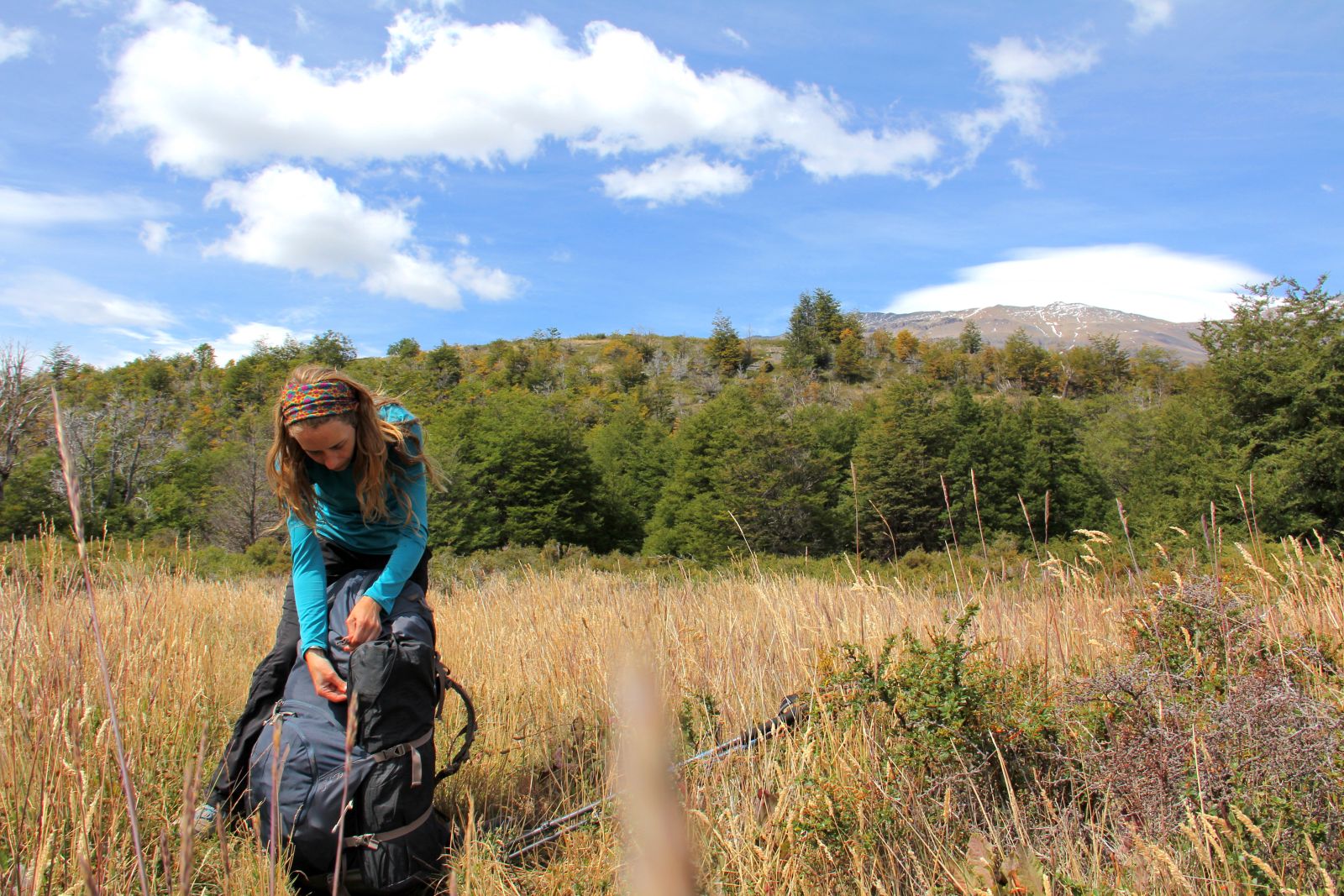
The mountain itself seemed to be hurling millions of tiny frozen pellets from every direction, some even rising up from the ground, all apparently aimed directly at our eyeballs. It was impossible to tell the depth of the snow, as it blasted across some rocks leaving them bare, and piled improbably high where larger rocks prevented its determined chase of the wind.
“You are lucky, this is the first snow of this year!” A park ranger gleefully shouted to us, bouncing by on legs that were much surer of the terrain than mine.
“Lucky?!” was all I managed to respond.
“Yes! We haven’t had snow since December, you’re the first to see it!”
At this point my boyfriend and I were halfway up Paso John Gardner, the highest point on the famous Paine Circuit, a backpacking route around Torres Del Paine National Park in Patagonia. The route forms a 75-mile loop around the sharp peaks and vertical towers of the mountains clustered in the center.
The park beckons hundreds of travelers to visit each day during high season (December through March), with more piling in each year. The insanely high popularity of the park necessitates strict rules for the hikers: no wandering off the single-marked trail, no camping outside designated tent sites, no walking on the trail at night. A trek through Torres Del Paine is not exactly a lonely wilderness quest, but nor is it approaching the sterile entertainment of a crowded Disney theme park, as some people claim.
The trek certainly lacks the creature comforts of a Disney Resort. The moment I woke up on the morning we planned to hike the pass, I regretted it. Before I opened my eyes, I heard weary drops of rain slapping the tent, the remnants of the assault of the previous night’s storm. I kept my eyes shut, trying to convince myself the sound was fading. “It will stop in a few minutes, I should stay in my sleeping bag for now,” I thought.
It didn’t stop.
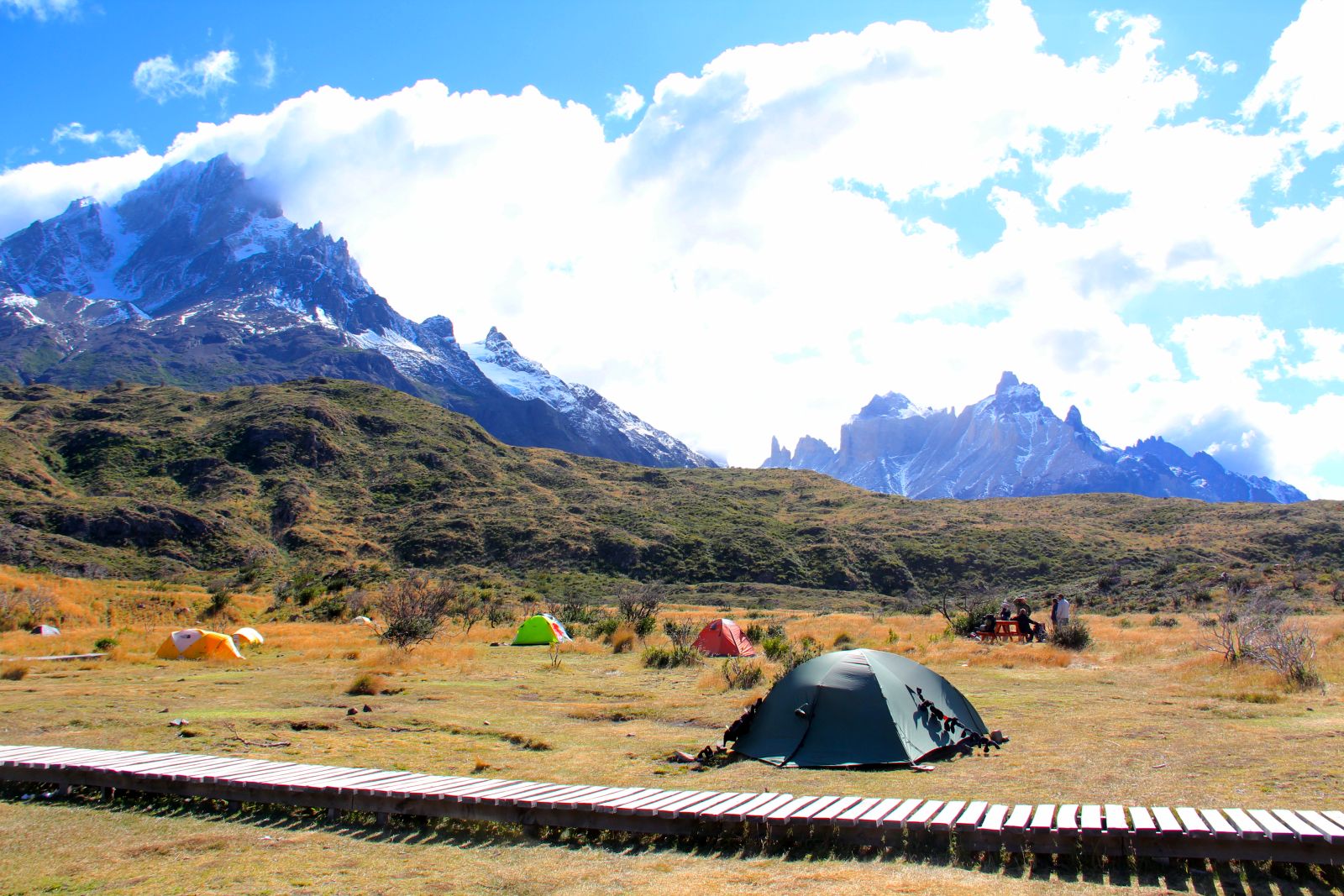
The necessity of getting an early start on the pass, however, eventually dragged me out of the relative comfort of the nylon walls. It’s not that I didn’t want to be outside in the rain. I can deal with putting on my rain jacket and shivering a bit in the sharp morning air. It’s that I was poignantly aware of the excruciating task that sat in front of us, like an unavoidable pile of dog shit in the streets of Santiago: packing the wet tent.
We knew we would probably face this challenge at some point on our nine-day trek. Patagonian weather is notoriously moody, and the rangers even posted a sign at one campsite that reads: “Don’t ask us about the weather, it’s Patagonia!” In a single day, a hiker can seemingly experience all four seasons as the weather turns from sunny and warm to windy and rainy to snowy and cold.
During this particular morning, a drop in temperature caused fat, wet snowflakes to begin interspersing themselves among the tired raindrops by the time we finished breakfast. The only task left was to pack the tent. Mud had made its way into every crevice, and by the time we’d wrestled the clogged buckles apart and peeled off the sopping rainfly (that part of the tent meant to deflect rain) our hands were already stiff with cold. Each time the tent fabric brushed against my hands, it felt like sandpaper was being rubbed against the raw skin. My boyfriend and I did our best to stay patient as we folded the rainfly.
“Fold it in half. No, the other way.”
“I thought we wanted to fold it in on itself?”
“That’s what I’m doing!”
“Give me that corner. No, not like that.”
“It won’t fit like this though.”
After a tense minute, the rainfly was piled into a vaguely rectangular shape on the ground. Next were the stakes and poles, which were apparently cemented into their clips by a combination of mud and gravel. Once we finally coaxed them out and the poles were collapsed, it was time to roll up the tent with the rainfly.
The ground was too wet to kneel as I normally would, so I squatted like a frog and laboriously scooted forward as I rolled the fabric as best as I could with hands that refused to bend. Tears of pain and frustration blurred my vision as I lifted the roll of soaking nylon and my boyfriend shoved it, inch by inch, into the bag, forcing it to fit so we wouldn’t have to refold it. Finally, he cinched it shut and we were done. Despite the steep climb that lay ahead of us, we knew the hardest part of our day was over.
We pulled our packs on, tightened a strap here and a strap there, and started our hike. Energy came back to our spirits with the warmth of our blood flow as we walked up the trail. Soon after beginning our ascent of the pass, though, I developed an appreciation for the fierce Patagonian wind about which we’d been warned.
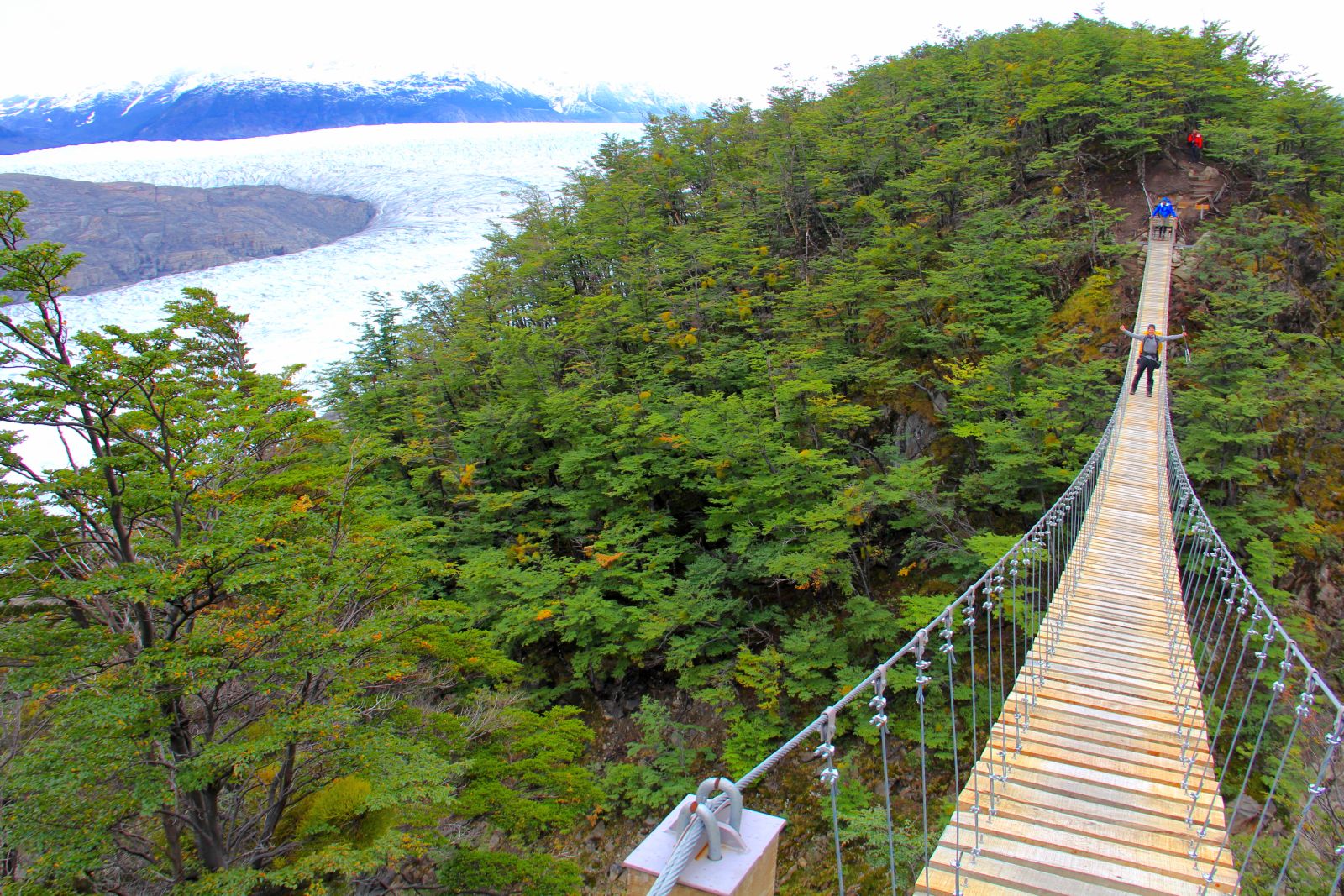
It’s not that the wind was relentless, but rather mischievous. One moment the mountain was completely still and a steady layer of snow fell from above, and within half a step a transparent force threatened to knock me to the ground (succeeding only once), while the falling pellets transformed into a swirling swarm of angry hornets. Ten or twenty steps later, it softened and remained quiet once again, coiling as a jack-in-the-box for its next powerful gust. My 40-pound backpack helped anchor me to the ground, but also acted as a giant sail pulling me backwards down the mountain with each push of the wind.
One step at a time, I defied both wind and gravity, shuffling up the mountainside at an embarrassingly slow pace. Half of my weight was entrusted entirely to my trekking poles as I leaned heavily into them, anticipating the next gust of wind. The rain and snow mix soon transformed completely into snow as we gained elevation. Partially frozen streams crisscrossed our route, and I prayed for no wind each time I precariously balanced myself atop the small stepping stones to avoid the freezing water.
It took four hours of careful trudging to reach the top. We stopped just a few times to admire the surroundings: the valley behind us that faded in and out of view with the clouds that passed over it, the needle-sharp ridges on each side that were too steep even for snow to stick, the thick glacier sitting just a few hundred feet to our right. All this was nothing compared to the view awaiting us on the other side.
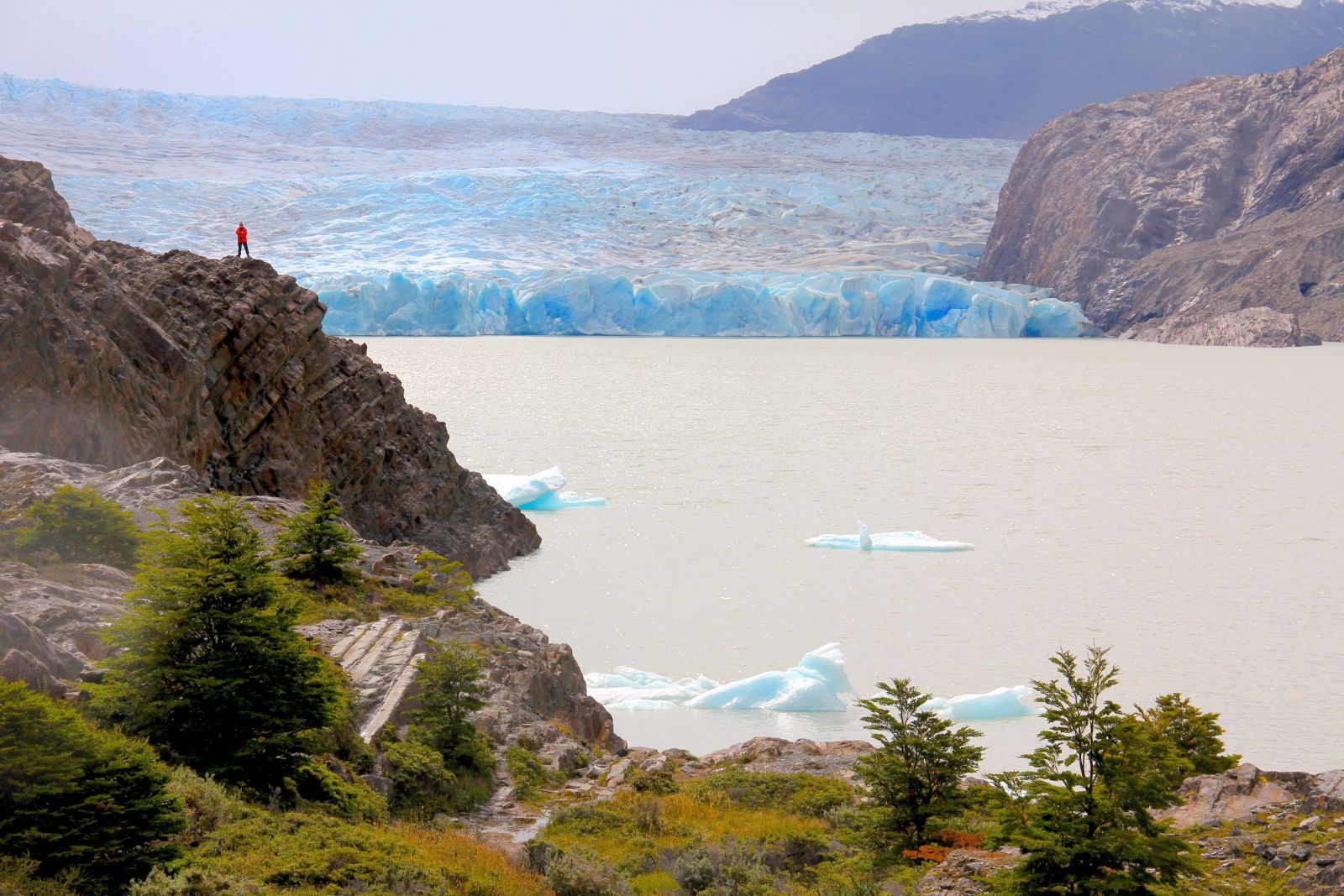
Looking at Glacier Grey from the top of the pass felt like we were in the presence of eternity. The silent glacier rested in the valley beneath us, with ice stretching back through the valley and piling up the mountainsides, eventually melting into the flat white of the February clouds. It looked like a pencil drawing, a scene in black and white. Except for the blue. That weird blue that only exists in layers of snow and ice. Like a cross between turquoise and electric blue, but with a hint of indigo and a neon glow. The blue showed up where crevasses in the surface of the glacier allowed us a glimpse into its depths.
It was hard to believe that this seemingly infinite glacier was just one small bit of the massive Southern Patagonian Ice Field. At 104 square miles, Glacier Grey forms less than three percent of the 4,773-square-mile sheet of ice stretching across southern Chile and Argentina. The ice field represents the remnant of an even bigger ice sheet from the last glacial period, and now feeds dozens of glaciers across the continent. These glaciers are still carving the landscape of the region, scouring valleys and moving mountains with their incredible force.
The mountain didn’t allow us to enjoy the view of Glacier Grey for too long, forcing us to keep moving to escape the barrage of wind and snow. And so we descended, down the steep and muddy trail into the camp. Down beneath the snow, into clouds and rain and five more mornings of wrestling the tent into its bag at various levels of saturation, and into the more crowded section of the circuit trail, where we were soon to squelch ourselves into over-packed cooking shelters and swap trail stories with dozens of other trekkers.
And of course, we trekked down under the watchful gaze of the mountain, who stands sentry over this section of Patagonia as countless hikers scramble circles around her formidable base. I believe it is something about the juxtaposition of unique beauty and exhaustingly dark conditions that draws these hikers to submit to the shifting weather and experience the awe-inspiring bit of nature that is Torres Del Paine.

 Laura works as a civil engineer to afford her true passions: backpacking, mountain biking, traveling, and writing. At the moment, she lives near Denver, Colorado, where she spends her free time playing in the Rocky Mountains and writing stories to share her adventures with others.
Laura works as a civil engineer to afford her true passions: backpacking, mountain biking, traveling, and writing. At the moment, she lives near Denver, Colorado, where she spends her free time playing in the Rocky Mountains and writing stories to share her adventures with others.
The post How To Pack A Wet Tent: A Trek Through Torres Del Paine, Chile appeared first on The Expeditioner Travel Site.
]]>The post Here Are Five Ways To Do Patagonia’s Torres Del Paine On The Cheap appeared first on The Expeditioner Travel Site.
]]>
Going on a multi-day trek through Patagonia is on a lot of people’s bucket list. Who doesn’t want to visit the Straights of Magellan, Patagonia and some of the most photogenic landscapes in the world? But if you look online the expense seems, shall we say, unfortunate. Okay, not unfortunate, nosebleed expensive.
Saying that you can visit Torres del Paine National Park on the cheap is a lie. You just can’t. It’s incredibly far away, Chile is an expensive country and Chilean Patagonia is even more so. If you look online, flights and tours alone can easily run in excess of $5,000 per person.
While a trip to Torres del Paine will likely never be categorized as cheap, there are a couple of easy things you can do to cut the cost of a trip almost in half.

1) Fly on Miles
A round-trip flight from New York to Punta Arenas will run you over $1,500 — which is about the same as five full-priced Virgin America round-trip tickets from New York to San Francisco. Or, at current Star Alliance prices, you can fly round-trip to Santiago for 60,000 miles with a $10 co-pay. Flights from Santiago to Punta Arenas run regularly and can be purchased from Sky Airlines or LAN and usually cost just a couple hundred bucks.
Don’t have a ton of miles lying around? There are a few clever ways for normal people to accrue tons of miles without being a corporate flier or super wealthy. I’m dead broke and haven’t paid for a flight in years, mostly because I follow The Points Guy like a disciple.

2) Don’t Take a Tour
If you Google “Torres del Paine tour,” you’ll get a seemingly endless number of tour operators eager to send you on an amazing, one-of-a-kind, trekking adventure. You’ll get to “sail up to the face of a towering valley glacier” and “hike above the ice of Grey Glacier” while listening to “the sound of ice calving off hanging mountain glaciers.” Sounds pretty intense — except that it’s all a huge rip-off.
Literally everything they’re offering on most of these tours is available to the general public at much lower prices when you arrive in Chile. The transportation, the accommodation, the food: it’s all the exact same thing you’d be doing if you just showed up and did it yourself.
It’s kind of like if you started a website in Mandarin Chinese that offered an “Amazing Manhattan Adventure,” Then for $2,000 you offered to take some poor sap on the Staten Island Ferry and up to the top of the Empire State Building. But that’s not all, you’ll also make sure to take care of their lunch at Ray’s Pizza and book them a room a Hostelling International — tidy profit margin.
When I was looking to go to Torres del Paine I found this well SEOed 4-day tour of the park marked for $1,950 a person. The price doesn’t include a flight and assumes you can get yourself to Puerto Natales, even though the closest airport to Puerto Natales is fours hours south. Check out what they’re offering:
“Day 1: Puerto Natales. Grey Boat. Hike Grey-Pehoe. Camp Pehoe.” That means you’ll take a $20 bus, get on a $30 ferry, walk on well-marked trails and camp in rented gear at a campsite that charges about $7.50 a night.
“Day 2: Hike Pehoe to Cuernos. Camp Cuernos.” You basically walk from one campsite to another and stay in another campsite that costs about $7.50 a night. The horrible thing is that this itinerary actually has you walking past a free campsite that’s way nicer. It also has you walking right past the French Valley, which is one the most impressive parts of the entire park.
“Day 3: Hike Cuernos to Chileno. Night refugio Chileno.” Like the day before, you’ll walk from one campsite to another, and then stay in a hostel that costs $40 a night.
“Day 4: Hike to base of Towers. Transfer to Puerto Natales.” You walk up a hill, look at the Torres Towers and then take a $20 bus back to Puerto Natales. Presumably you’re on your own to get back to the airport in Punta Arenas.
Total Value: $121.50. To be fair, the tour also includes food (about $130 a day if purchased in the park), park entrance ($40), rented camping gear ($200), an English-speaking guide and porters to take care of your bags.
That means you could do the same thing for $881.50 and still have $1,068 left over to hire some guy to show you around incredibly well-marked trails. Or you could use it to buy a flight.

3) Camp
There are a series of hostels, or refugios in Torres del Paine parlance, set up around the park. They’re big, modern and warm, and have all the amenities of a hostel in a city. They also have considerable downsides. They’re expensive, they book up months in advance, and they are packed full of the sort of people who took that $2,000 tour.
The park has several absolutely free and very well maintained campgrounds. There are other campgrounds that charge a couple of dollars and offer all sorts of amenities. I’m talking about hot water showers, clean flushing toilets, electrical outlets and access to small stores.

4) Bring Your Own Food/Booze
You can, and many people do, purchase all your food while you’re inside the park. For about $130 a day the refugios offer a full day’s food, and from what I could tell, it looked pretty good. But for much cheaper, there’s a large, modern grocery store outside the park in Puerta Natales. They have a good selection of camping-appropriate foods and a decent booze selection.
Speaking of booze, there are bars at the refugios inside the park, but prices are extortionary — they know you’ll be thirsty for a strong drink after a long hike. Think ahead and grab a bottle of something stiff in Puerta Natales. I highly recommend packing in a bottle of whiskey for its high alcohol-to-weight ratio. Not only will you be the most relaxed person at the campsite, you’ll also be the most popular.
5) Rent Your Gear
Because Torres del Paine is such a remote destination, it attracts a lot of campers with deep pockets. These campers then go hog-wild at their local gear store buying some beautiful equipment that’s complete overkill.
I watched one French octogenarian spend about an hour trying to figure out how to set up a brand new $700 tent that I’m guessing will spend the rest of its life in an attic. Once he figure out how to get the tent up, he then spent the next half hour putting together $600 worth of super lightweight trekking cots for him and his wife. While I’ll admit a certain amount of gear jealousy, it seemed like a bit absurd.
If you go trekking all the time and have gear, awesome. But for the rest of us, there’s no need to drop several thousand dollars at Eastern Mountain Sports before leaving home.
Just outside the park in Puerta Natales there are tons of places that will rent you everything you’ll need for about $50 a day. The gear they’re offering is chosen specifically for the needs of hiking in Torres del Paine: light, wind-resistant and warm.
*
The fact of the matter is that taking on Torres del Paine will never be cheap. That said, it can be done far cheaper than you’d expect. And, regardless whether you pay $800 or $8,000 for the trip, your pictures will be just as beautiful. Take that extra cash and tack on some time enjoying Santiago or the incredible street art of Valparaiso before heading back to the States.

/
 You’ll likely find Anthony traveling, hiking, cooking or horribly mangling photos in Photoshop. When that doesn’t work, he drinks whiskey. Anthony used to cover city news, business and politics for DCinno in Washington D.C., but left to explore South America. Now you’ll find him drinking whiskey on the beach.
You’ll likely find Anthony traveling, hiking, cooking or horribly mangling photos in Photoshop. When that doesn’t work, he drinks whiskey. Anthony used to cover city news, business and politics for DCinno in Washington D.C., but left to explore South America. Now you’ll find him drinking whiskey on the beach.
The post Here Are Five Ways To Do Patagonia’s Torres Del Paine On The Cheap appeared first on The Expeditioner Travel Site.
]]>The post A Wine Lover’s Guide To Casablanca Valley, Chile appeared first on The Expeditioner Travel Site.
]]>
When wine lovers talk about their dream destinations, they always hail the famous Chiantis of Tuscany, the warm Cabernet blends of Napa or the crisp Sauvignon Blancs of the Loire Valley.
Too often, Chile is merely a whisper. The lush, vine-covered hills of the Casablanca Valley have remained mostly under the radar. However, Chile’s superb wine climate, rich soil and booming economy have turned the region into an untapped wine lover’s paradise.
As an avid wine lover and viticulture destination hopper, I had heard about Chile’s young, but vibrant, wine culture and had tasted their oaky Chardonnays and dry Pinot Noirs here at home, but I decided I had to visit the source myself.
Could Casablanca Valley be the next Napa? I decided I was going to find out.
Getting There
Chile, a sliver of a country on the western edge of South America, is like an upside down California. It is bordered by Argentina, Peru and Bolivia, and extends into Antarctica and the Drake Passage in the south.
I was lucky enough to fly during the day into Santiago and got a a slight glimpse of Chile’s unique topography. From volcanoes to fertile valleys to inlets of icy fjords and tropical islands, Chile has many different areas to explore.
However, I was headed straight for the large expanse known as the Casablanca Valley. Casablanca Valley is actually part of the Aconcagua Valley, Chile’s third designated viticulture region, and is located about an hour west of Santiago towards the coastline.
The Central Valley Characteristics
Chile’s unique geography and location is the reason it is one of the only places left in the world that can grow the elusive Carmenère varietal. The Carmenère grape grew abundantly in Bordeaux, France, producing dark red wines until 1867 when it was hit by the phylloxera plague. These tiny, sap-sucking pests wiped out Carmenère crops all over the world. Chile’s grapes were protected in the east by the cold Pacific Ocean air, in the north by the barren Atacama Desert, in the south by the frigid Antarctic glaciers and in the west by the Andes.
Driving out of the airport into the Casablanca Valley, I was struck by how similar parts of it look to California’s wine-producing regions. Even though the vineyards of Chile have the South American equivalent latitudes of North Africa, the climate is classified as Mediterranean. I had read that the climate of Casablanca is comparable to the Californian wine region of Carneros. This was welcome news to me, as I was a fan of both Chardonnay and Pinot noir — popular varietals from both regions.
Local wine expert and tour guide Ines Wiegand told me the climate and soil are why Chile produces such delicious wines. “Our soil is formed by clay and a little bit of sand, which helps with the humidity to form the exact combination to get our delicious varieties of wine.”
I planned my journey during the early April harvest — Chile’s early Fall, which meant that I experienced the airy sunlight and comfortable 70-degree weather as I curved through the sloping hills along Ruta 68, the Autopista Del Pacifico. The Casablanca Valley is one of the few wine regions that does not depend on irrigation from melting snow in the Andes due to its proximity to the coast.
However, when I stopped to buy some local olives, a farmer warned me that the Pacific’s Humboldt current can sometimes blanket vineyards in a cold marine layer. “Always have your jacket with you,” he advised me in his thick Chilean Spanish, a slightly different variant of the Castilian Spanish I had learned back in school.
I continued driving through the amazingly expansive valley. In total there are over 3,531 acres planted in the region and grow. In order of quantity, they are as follows: Chardonnay (5,607 acres), Sauvignon Blanc (4,819 acres), Pinot Noir (1,787), Merlot (966 acres), Syrah (277 acres), Gewurztraminer (161 acres), Viognier (121 acres), Pinot Gris (84 acres), Riesling (82 acres), Cabernet Franc (32 acres) and Malbec (15 acres).
The Vineyards
Wine lovers have a large variety of choices in the area. Here are some of the most popular wineries that pair superb tastings with picturesque views that you can check out.
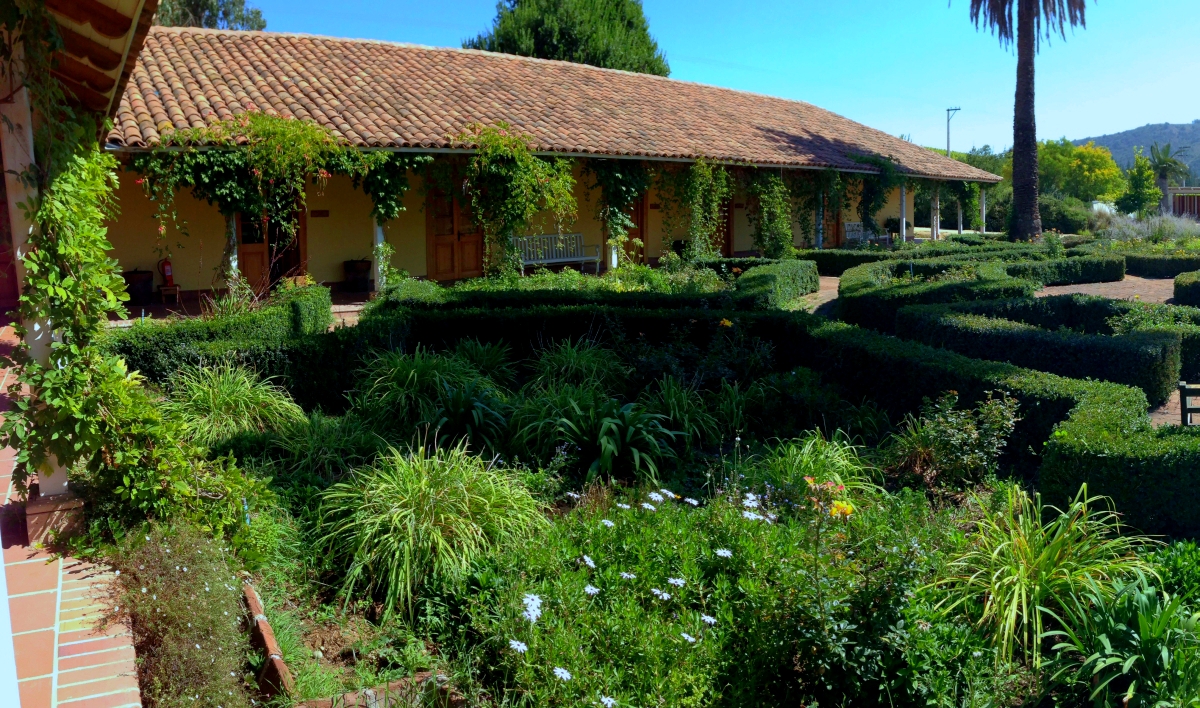
1) Matetic
Matetic winery specializes in making organic biodynamic wines. Located on the border of Casablanca Valley and the Rosario Valley, Matetic boasts a new state-of-the-art winemaking facility designed by architect Laurence Odfjell.
During the tour of the stunning facility, you will learn how their 300,000-liter capacity tank relies on a gravitational flow design to optimize storage of the fermenting grapes. During a tasting, be sure to try their famous “EQ” Sauvignon Blanc, which has a spicy bouquet of fresh pear and tangerine, perfect for a warm afternoon. In addition to their Sauvignon Blanc, they also produce Chardonnays, Pinot Noirs and Syrahs.
2) Veramonte
Veramonte is one of the largest vineyards in Chile, with over 1,000 acres in the Casablanca Valley. Its California-style facility by Chilean architect Jorge Swinburn is nestled in forest-filled hills, home to more than 24 species of birds.
This is a great vineyard to visit for families, as the Veramonte property not only has an antique winemaking exhibit hall filled with old barrels and wine contraptions, but also boasts picnic and game areas among the vines and olive trees. Their most popular varietals are Sauvignon Blanc, Chardonnay, Pinot Noir and Merlot. Their Veramonte 2012 Syrah Rose is a deep pink, raspberry-scented summer wine, which is wonderfully crisp on the palate.
3) Indómita
The Indómita castle-like winery floats on top of a vine-covered hill right at the start of Casablanca Valley. Their Casablanca Valley location focuses on white wine. Their Duette Chardonnay 2009 is particularly delightful with a hint of pineapple and boasting a buttery texture. Wine is not the only treat at Indómita: in-house Chef Oscar Tapia serves gourmet Spanish Chilean lunches daily at Restaurante Viña Indòmita on the property.
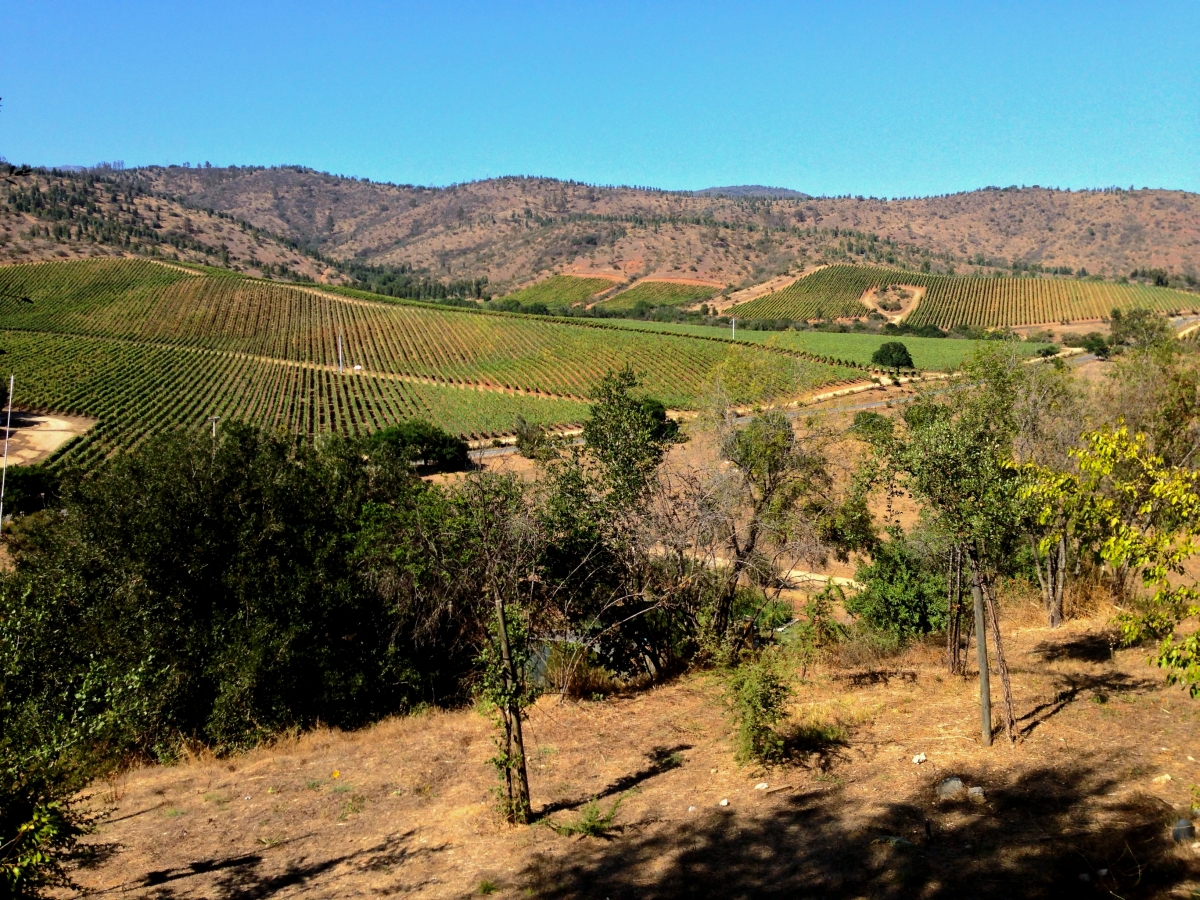
4) Casas del Bosque
Indómita isn’t the only place to get a decadent lunch in the valley. Casas del Bosque is a family boutique winery that offers premium wine and terrace dining at their Tanino Wine Bar & Lunch. Here you can get Chilean delicacies and sip their unique Syrah created in this cool coastal region. Their Gran Estate Selection Private Reserve 2007 is particularly noteworthy with its intense violet color and bouquet of blackcurrant, blueberry and anise.
5) Vina Morandé
Pablo Morandé planted Casablanca Valley’s first vineyard in 1982. Over 320 acres of vines make up the Belén Estate in the Casablanca sector known as Lo Ovalle. The sleek, glass-and-wood building is surrounded by vines, most of which produce Chardonnay and Pinot Noir. Another superb restaurant on the vineyard, House of Morandé, serves up an international menu by Chef Christopher Carpentier. Be sure to try their sparkling wine, Morandé Brut Nature, which is 60% Chardonnay and 40% Pinot Noir, and has a delicate sweetness.
Conclusion
Could the Casablanca Valley be the next Napa or Sonoma? While both the wine and views are more than comparable, it’s nearly impossible to squeeze all of the sites and tastings into one weekend. Perhaps that makes it better than either of those American wine regions. In reality, the most difficult part of my trip, if anything, was simply the act of having to leave.
*
Matetic
www.matetic.cl
Veramonte
www.veramonte.com
Indómita
www.indomita.cl
Casas del Bosque
www.casasdelbosque.cl
Vina Morandé
www.morande.cl

/
 Vanessa Van Edwards of ScieneOfPeople.com is a published author and behavioral investigator. She is a professional people watcher—speaking, researching and cracking the code of interesting human behavior for audiences around the world. Vanessa’s groundbreaking workshops and courses teach individuals how to succeed in business and life by understanding the hidden dynamics of people. Vanessa is a Huffington Post columnist and Penguin author. She has been featured on NPR, the Wall Street Journal, the Today Show and USA Today. She has written for CNN, Fast Company and Forbes.
Vanessa Van Edwards of ScieneOfPeople.com is a published author and behavioral investigator. She is a professional people watcher—speaking, researching and cracking the code of interesting human behavior for audiences around the world. Vanessa’s groundbreaking workshops and courses teach individuals how to succeed in business and life by understanding the hidden dynamics of people. Vanessa is a Huffington Post columnist and Penguin author. She has been featured on NPR, the Wall Street Journal, the Today Show and USA Today. She has written for CNN, Fast Company and Forbes.
The post A Wine Lover’s Guide To Casablanca Valley, Chile appeared first on The Expeditioner Travel Site.
]]>The post La Carretera Austral: The Gravel Road To The End Of The World appeared first on The Expeditioner Travel Site.
]]>
Pan-American Transmissions: Part 12
“Pan-American Transmissions” is a travel series from Special Contributor Diego Cupolo as he travels south from Nicaragua to Argentina. He has few plans, a $10-a-day budget and one flute-playing gypsy companion. Check back as new dispatches are posted from the road.
The overnight boat approached mainland Chile beneath the shadow of the Chaitén Volcano, a gaping caldera that erupted in 2008, burying the port below. Gray cinder still sat on the rooftops of abandoned houses along the coast and a thick sponge of ash floated in the water below us, forcing the captain to anchor offshore and wait until high tide in the early morning to dock safely.
Standing there, on the upper deck, I watched the sun rise over a jagged landscape so green it made the dismal ashtray of a town seem like a small footnote of human misfortune in a vast terrain of unspoiled natural beauty. This was Patagonia.
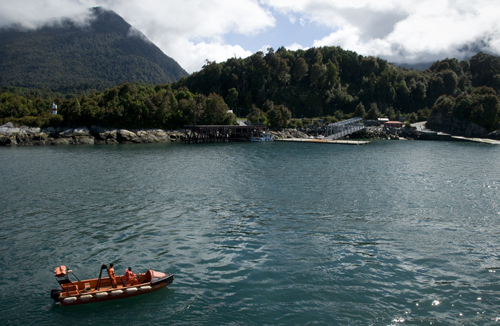
Around me, a strange mix of passengers waited anxiously to disembark. They were Czech film crews, Danish Hell’s Angels, Japanese mountaineers and cross-continental cyclists of all nationalities. We boarded in Chiloé and together we sailed through the night, bounded by one all-consuming, unreasonable need to reach the end of the world: Ushuaia.
To reach this city at the southern tip of South America, one can choose between two paved Argentinian routes or Chile’s Carretera Austral, a 770-mile (1,240 km) stretch of mostly gravel mountain passages through the most vibrant and least inhabited regions of Patagonia. Having been completed in the early 1980’s, the road gave access to long isolated areas and locals like to call it the only good thing former dictator Pinochet ever did.
When our boat finally docked that morning in Chaitén, the fervent passengers rushed out down the highway like horses at the track. I, too, was fervent, but hungry, as well. Inside the town bakery, I gnawed two-day-old bread as I spoke with the lady behind the cash register, trying to get a sense for the route ahead. Traffic would be less than sparse, buses were few and all forms of transportation were severely expensive.
At that moment, I remembered a song by Joan Manuel Serrat. A friend had played it for me before I left Buenos Aires and he highlighted one verse in particular: “Caminante son tus huellas el camino y nada más; Caminante no hay camino, se hace camino al andar,” which roughly translated into, “Walker your footsteps are the path and nothing more; Walker there is no path, the path is made by walking.
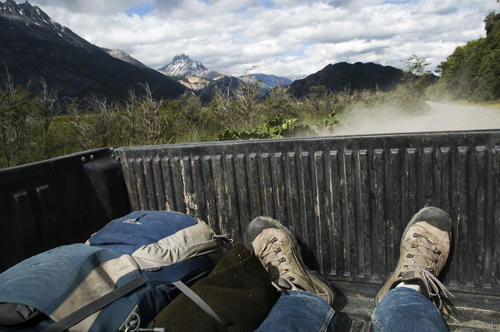
Standing in that bakery, stale terrible bread in hand, I decided to go down the Carretera Austral on foot. I’d accept the occasional lift — when there was one — but I would go on to spend the majority of the next month marching towards Ushuaia, the end of the road, a place I’d been trying to find ever since I got off training wheels.
This was it. Two legs, a 25-kilo backpack, a bag of oatmeal and a sack of powdered milk. Sixteen months after landing in Nicaragua, this grand Pan-American voyage was coming to a close.
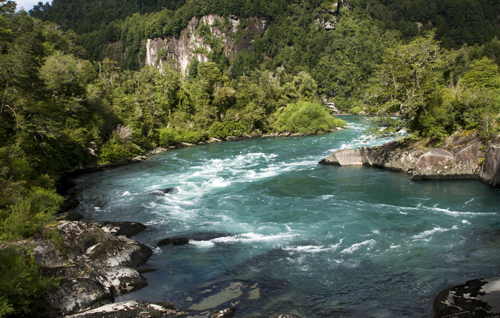
Se Hace Camino al Andar: Down the Futaleufú to Queulat National Park
My instincts were right, but the direction was wrong. After the first day on the road I woke up in Futaleufú, a town near the Argentinian border, about 50 miles off course. I had spent the prior day in Parque Pumalín, one of many large conservation areas in southern Chile owned by North Face co-founder Douglas Tompkins, prompting suspicious locals to accuse him of creating some kind of secret Zionist state.
When I popped out of the bushes I caught a ride to with an Argentinean hippie couple heading to Futaleufú. I asked if the town was south on Carretera Austral and they said yes, but that was a lie. Stranded and with few options, I started walking back towards the highway. About four hours later, a truck hauling two rafts stopped and gave me a lift. The driver said he was starting a new whitewater rafting company and was about to shoot a promotional video.
“We need one more guy in the raft,” he said. “We’ll give you all the gear and drop you off downriver near the Carretera Austral free of charge. It’s your lucky day. Do you want to join us?”
I didn’t know it, but we were just next to the Futaleufú River, a world-renowned water sports destination with Class 5 rapids. I had only been whitewater rafting once before in Chattanooga, Tennessee, but agreed to go along because, hell, who wouldn’t? Suited up, with a yellow paddle in hand, I climbed into the raft with three guys that had Go Pro cameras attached to their helmets.
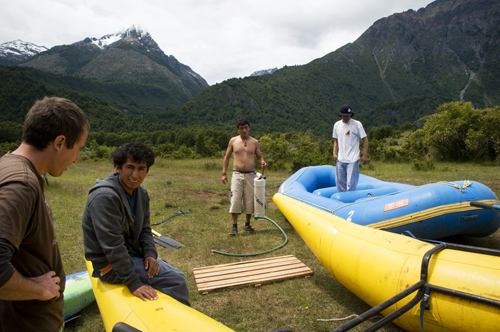
Together we floated down the bright turquoise river towards rapids with names like “The Terminator” and “The Himalayas.” As the raft approached the first set of rapids, a canyon of roaring white foam broken only by massive boulders, the guy in the back began shouting instructions. “Right side paddle! Stop! Left side paddle! Right paddle backwards! Everyone! Weight on the right!” Failing to follow commands meant flipping over.
For the next two hours I didn’t see much more than my paddle and white foam. At some points, the front end of the raft would go airborne and my paddle wasn’t long enough to reach the water below. At other points, violent waves crashed over the nose, blinding us for one second too long, leaving the raft at the mercy of the next wave. People do this for fun. Paddle or die.
By the end we were all howling like wolves. The final rapids were Class 4 and, well, I could actually enjoy those because I could see what lay ahead. We ran the whole course of the Futaleufú River — or “Big River” in the native Mapuche language — and as promised, the guys let me off near the Carretera Austral. Just like that I had gotten back on course. Completely drenched, freezing cold and still shaking with adrenaline, but back on course.
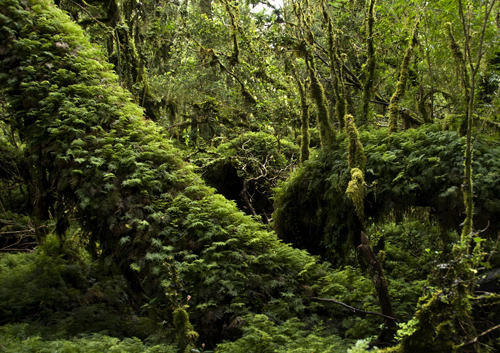
That night I camped on the side of the road with a retired baby boomer couple from Santiago that had picked me up in their Volkswagen RV. We drank Crown Royal and they showed me all the Apps of their new Samsung tablet. In the morning, the two dropped me off in Queulat National Park, where mountaintop glacier fields melt into a thousand waterfalls above misty Pacific rain forests, and an entire new day in Patagonia began to unfold.
I stashed my bag behind a fallen tree and hiked up the Bosque Encantado trail with a group of Israeli backpackers. Climbing in the light fog, we worked our way through a maze of green moss that connected every branch, stone and leaf, making the forest seem more like a single living organism than individual trees or plants.
After lunch it started to rain, as it often does along the Pacific coast. I grabbed my bag and continued south on the Carretera Austral. Rain soon turned to downpour, but I kept walking, using a big nalca leaf as an umbrella until I reached Piedra del Gato, a small gorge about 13 miles down the highway.
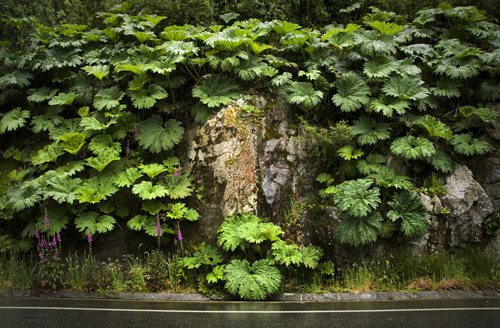
There, while I stood on the side of the road, looking down at the another set of turquoise river rapids, a local pulled over. His name was Erwin and he was a fisherman. He knew every island, mountain and river in southern Chile. From time to time, he worked as a helicopter guide for rich tourists looking to go “deep” into the mountains. Erwin laughed at me, standing in the rain with my nalca leaf umbrella and asked if I knew how to eat nalca.
“You can eat this?” I asked.
“Claro. Of course, but only the stem,” he said before jumping out of his old pick-up truck and finding a few plants.
Erwin said the best plants for consumption were young and had flexible stems. The taste peaks just before if the leaf opens. Erwin took a stem, shaved off the red spikes with a knife and cut me a piece. It tasted like celery, only more juicy and more bitter. Not bad.
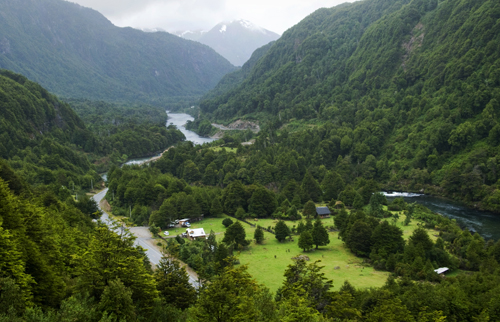
“These grow in every rainy region of Patagonia. You can live on them,” he said. “You know, one time a 70-year-old man got lost in these woods and rescue squads couldn’t find him. About a month went by before they called off the search, assuming he was dead, but two months after that, the guy came out of the forest alive and well, having survived on a diet of nalca stems. He was 70 years old.”
“They’re also good for digestion,” he added as he took a bite. “If you have a stomach ache, they’ll probably make it go away.”
Erwin dropped me off outside Coyhaique where I dried my clothes over a campfire for the night. His advice on nalca plants and forest survival would prove more than valuable for the rest of the trip and I kept his number in case I ever have enough money for a Patagonian helicopter tour.
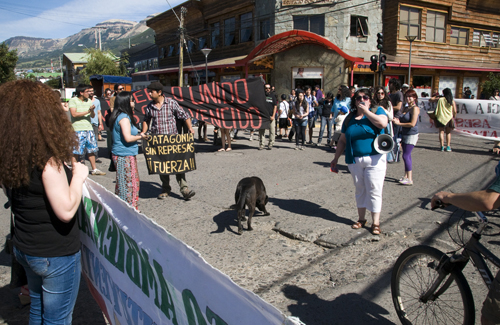
Son Tus Huellas el Camino: Coyhaique and Lago General Carrera
The apocalypse came and went and 2013 arrived as I reached Coyhaique, a city of 50,000 inhabitants. Civilization, at last. Internet cafes, organic quinoa cookies and teenage goth punks with lip piercings. I stayed with a local couchsurfer for a week as I conducted interviews and attended protests against HidroAysén, an $11 billion hydroelectric project that aims to build five dams in two of Patagonia’s largest rivers. One of several divisive issues in Chile at the moment.
In the meantime, I also visited the autonomous communities rising along Coyhaique’s city limits. House prices in Patagonia can be astronomical, so a growing number of young people are buying small plots of land and building their own homes from scratch. The resulting off-the-grid villages sprouting up throughout southern Chile make for a compelling social experiment.
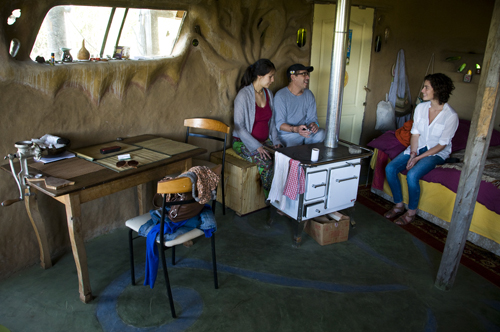
The slow country life and open-minded people made Coyhaique an easy place to stay for a while, but I had to keep moving and continued south as soon as I finished my research. Two days and three rides later, I passed through Reserva Nacional Cerro Castillo — the poor man’s Torres del Paine — and reached Lago General Carrera, Chile’s largest and probably most scenic lake.
Here, the Carretera Austral runs through some of the most beautiful landscapes in the world. No amount of open-mouth staring can suffice. I set up camp along the lakeshore in Puerto Rio Tranquilo and watched the pink cliffs melt slowly into cyan waters over and over again. A natural hypnosis.
The next morning came with a mess of rain. This was to become a recurring theme throughout the trip. In southern Chile, coastal areas are especially prone to showers while interior regions enjoy much drier weather. This is the case with Chile Chico, a town known for its pleasant Mediterranean micro-climate near the Argentinian border.
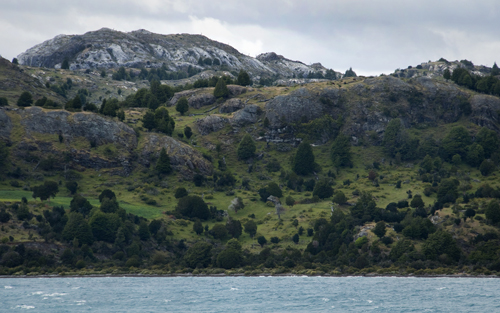
Hoping to get out of the rain, I made my way around the lake towards Chile Chico and arrived in Puerto Guadal, a small village on the verge of being abandoned. The streets were empty, all the windows were shut and the stores were closed. I tried knocking at the door of the grocery store, but no one answered.
Halfway to starving, I found two rotten apples in a trash pile behind the store and was considering them as a meal when a middle-aged woman appeared on the street. She was round, disheveled and walked in zig-zags. The first sign of life in the village. I approached her to ask about the store.
“Buenos dias, discuple,” I said to be polite. “Do you know if the grocery store is open at this time?”
She looked at me like snakes were coming out of my mouth. Her lips pressed shut and her eyes widened with manic confusion. She seemed disturbed by the sight of my face and kept watching me as she walked away without saying a word. As I write this, I still wonder what she saw during that long, strange moment. That kind of insanity is contagious and must thrive in these small mountain villages.
No one else passed for a while and then the store owner finally arrived. I entered bought my Patagonian staple food: bread and tubed cream cheese (the cheapest food in a region that produces little aside from meat). I ate as the rain became heavy again and then went on my way down Route 265 towards Chile Chico, to the dry weather everyone talked about.
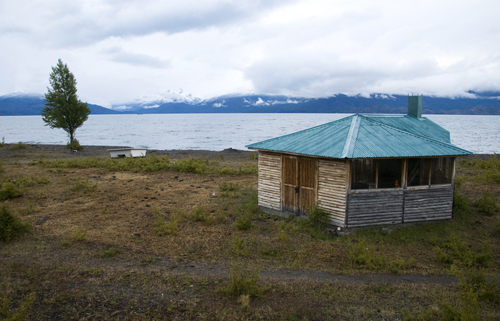
I never made it. The showers made a stream of the gravel road and about four cars passed in the six hours I had been walking. The sun was setting and I was soaked again. Without a dry place to sleep, I took refuge in the barbecue hut of an empty vacation house, a structure locally known as a quincho. The door was unlocked and there was a stack of wood next to the grill so, well, I made a fire and hung my clothes to dry.
Adventure means going outside your comfort zone and considering all the wet, miserable places I could’ve ended up, the shelter of this quincho wasn’t bad at all.
The rain stopped the following morning and I woke up to a clear view of Lago General Carrera with snow-covered mountains on the opposite shore. You could say it was a well-placed vacation home. I collected driftwood to replace what I had used through the night, packed up, and once again made my way back to the Carretera Austral, abandoning any hopes of reaching Chile Chico.
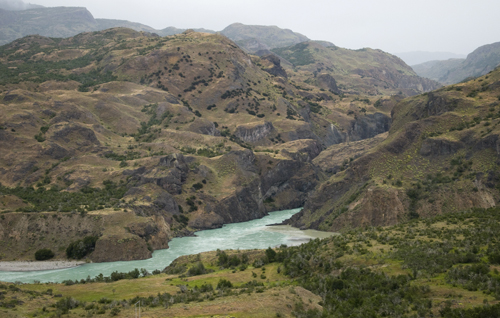
Caminante no Hay Camino: Cochrane, Caleta Tortel and Villa O’Higgins
Through the final and least transited section of the highway, I spent many nights camping along riverbanks and many days walking non-stop, fueled by an abundance of nalca plants. Thanks Erwin. Though I was alone on foot, I had daily encounters with a trio of Chilean cyclists that were biking the entire road. We traveled at about the same pace and we often shared lunches, travel stories and all-important weather reports.
Locals say “those who hurry in Patagonia lose time,” and we made sure to go as slow as possible through the open country. After the night in the barbecue hut, I walked to Lago Bertrand and then south along the Rio Baker, one of the two rivers currently threatened by hydroelectric dams.
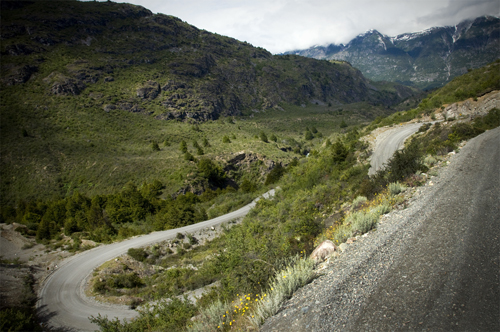
When I reached Cochrane, a town of 3,000, I stayed with another couchsurfer as I finished up a few more interviews on the HidroAysén project. My host was nice. He looked like Trent Reznor and made big, vegetarian meals, but he had just broken up with his long-time girlfriend and there were a few holes in his bedroom door at about fist level so I made sure to tread lightly and stay briefly.
The further south I went, the more “tavanos”, or giant horse flies, there were. The bastards like to bite and every time you kill one, ten more show up to fly around your head. Still, the scenery was incredible. I look back at my photos and, though I was there, I still cannot believe these places exist.
A good example was Caleta Tortel. The Chilean cyclist told me to visit the small port town, wedged between fjords on the Pacific shore, so I took a detour off the Carretera Austral towards the coast on a road that was completed only in 2003. On arrival, a maze of wooden plank stairways and walkways led through a strange settlement of stilt houses with smoking chimneys and tired sailors smoking pipes.
Among the seafarers was an Alaskan who sailed around the world three times in a 15-meter boat. He was old, didn’t smile much and had just come around Cape Horn on a straight shot from Norway. He said he once spent 78 days out on the sea, alone, while crossing the Pacific. His secret: an on board dutch oven for baking bread.
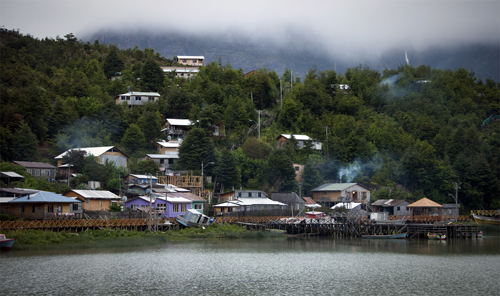
Aside from the sailors, Caleta Tortel was a little dull and overpriced, a consequence of heavy cruise ship tourism. I got back on the Carretera Austral, crossed the Rio Bravo on a free ferry and got picked up by a French couple on the other side. Together we drove through the rugged mountain valleys that make up the last 90 km of the highway. Along the way, we spotted a pair of local fishermen in the Rio Mayer and bought two mid-sized trouts for USD$3.00.
That night, the three of us cooked fish with rice over a campfire on the lakeshore and, well, life was good. We shared two bottles of wine and I learned they were Calculus majors visiting Chile for an international mathematics conference. You never know who you’ll find on the road.
In the morning we arrived at Villa O’ Higgins, the somber end of the Carreterra Austral. With just 500 residents, the village acts mainly as a backdoor entrance to Argentina. An expensive ferry, (about USD$80.00) provides sporadic transit across Lago O’ Higgins to Candelario Mancilla where travelers can hike about 20 miles over a several mountains to reach the nearest road in Argentina. Except for two military border checkpoints, there’s nothing out there. I pitched my tent and waited for the next ferry, collecting necessary provisions in the meantime.
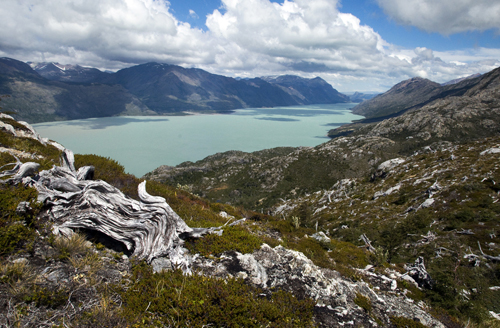
Y Nada Más: Crossing to Argentina, Reaching Ushuaia
The journey down the Carretera Austral began and ended with a boat ride. Because of the Southern Chile’s rugged mountain terrain, there are no overland routes from Villa O’Higgins to Tierra del Fuego, forcing both travelers and locals to cross over to Argentina in order reach Chile’s southern tail.
On a sunny Friday morning, I rode the ferry across Lago O’Higgins and shared one last lunch with the Chilean cyclists before setting off for Argentina. With 25 kilos of crap on my back, following this tiny trail up and down mountain valleys would make for one of the hardest hikes in my life.
For two glorious days I walked in a silence broken only by the occasional crack of a mountaintop glacier. A sharp echo would bounce off the valley walls, and I’d look up just in time to see an avalanche of ice pour into the river below. In front of me, Mount Fitz Roy jutted into the sky like massive canine tooth of bedrock, and this handsome mountain served as a beacon for El Chaltén, the closest town in Argentina.
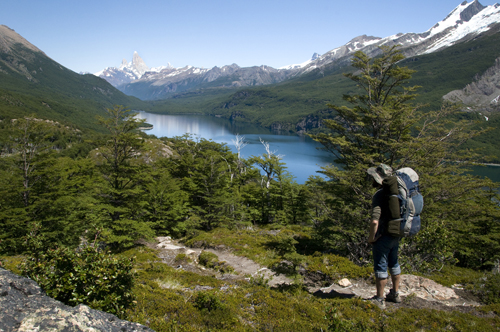
I camped on the shore of Lago del Desierto and hiked through the forest until I reached some kind of vacation resort on the opposite shore. It was packed with screaming children getting scorned by their screaming parents. Civilization once more. After that it was easy. All the Patagonian mega-attractions — El Chaltén, El Cafate, Torres del Paine National Park — were connected by wide, smooth highways, and as a result, they were filled with tourists and extremely high prices.
Of course, the scenery was amazing, but not much different from the landscapes along the Carretera Austral. The same was true for Ushuaia. Retired Swiss tourists filled the streets, paying top dollar for everything, from bread to bunk beds, all to see about the same sights anyone can enjoy in Chile, free of charge.
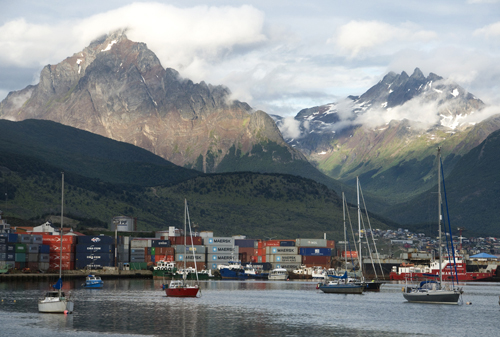
It’s sad when you realize your final destination is nothing more than a tourist trap, but, excuse the cliche, it was the journey that mattered. Few destinations in world can compare with the untamed wilderness in Southern Chile, and there’s no better way to experience it than by walking, biking or driving down the Carretera Austral. The key is to stop thinking, saving, planning and dreaming, and just go. The rest will work out. “Se hace camino al andar” can also mean “The path is made by going forward.”
To commemorate the end of the journey I shaved off my mountain beard in Ushuaia and threw it into the Beagle Channel, a passage named after the ship Charles Darwin boarded at this very same port to reach the Galapagos Islands. Without the funds to stay in town for more than two nights, I caught a lift back to Buenos Aires with a Brazilian truck driver and that was it. I flew back to Montreal to be with Ania again.
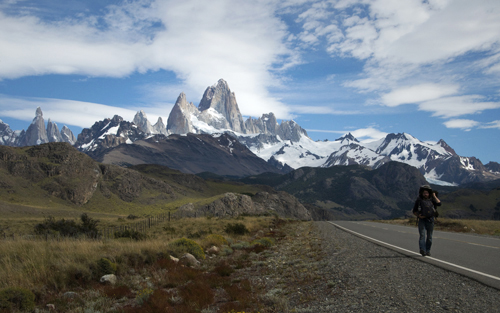
Looking back, Moving forward
Nicaragua to Tierra del Fuego. You’re supposed to have big, thoughtful observations after long expeditions into foreign lands. The world becomes smaller. Vague terms like “poverty” and “globalization” gain meaning. You change. The people around you change. Yet, still, it takes time to digest a year and half on the road.
For now, I’ll just say that throughout those long, peaceful days spent walking along the Carretera Austral, I’d look at the mountains, the rivers and the lakes and they seemed so separate from humanity, so indifferent to our presence. Through every war, dictatorship and mistake we ever made, those valleys remained the same. Untouched. I wanted to stay there for the rest of my life.
Not long after, I realized this observation was wrong and not simply because I was walking on a man-made highway. When I arrived in Tierra del Fuego, locals were in shock over the recent heat waves were hitting the Antarctic island. They never experienced such balmy weather patterns and the uncomfortable sweat on their brows came with tinge of fear.
With that thought, I rode back through the dry Argentinian plains and returned to North America. Traveling and having fun is great, but we — all seven billion of us — have a lot of work to do if we want to continue enjoying places like Patagonia and, in a broader sense, our time together on this tiny planet.
Thanks for reading.
By Diego Cupolo
Read all of the other Pan-American Transmissions entries here.

About the Author
 Diego Cupolo is a freelance photojournalist currently on the road to Tierra del Fuego. Most recently he served as Associate Editor for BushwickBK.com, an online newspaper in Brooklyn, and his work has appeared in The New Yorker, The Atlantic, The Star-Ledger, The Australian Times, Discover Magazine and many other publications. View more of his work at DiegoCupolo.com.
Diego Cupolo is a freelance photojournalist currently on the road to Tierra del Fuego. Most recently he served as Associate Editor for BushwickBK.com, an online newspaper in Brooklyn, and his work has appeared in The New Yorker, The Atlantic, The Star-Ledger, The Australian Times, Discover Magazine and many other publications. View more of his work at DiegoCupolo.com.
The post La Carretera Austral: The Gravel Road To The End Of The World appeared first on The Expeditioner Travel Site.
]]>The post The Driest Place on Earth: From Bolivia’s Salt Flats To Chile’s Atacama Desert appeared first on The Expeditioner Travel Site.
]]>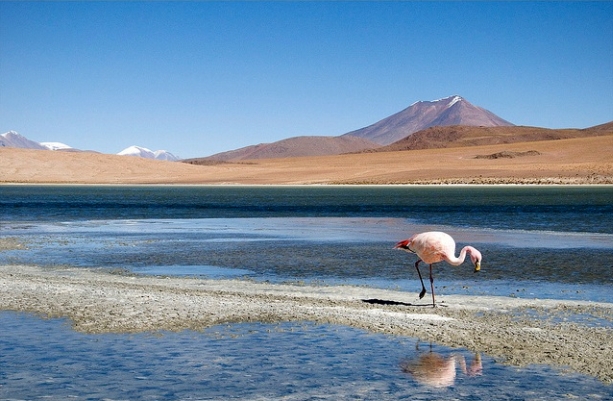
Pan-American Transmissions: Part 11
“Pan-American Transmissions” is a travel series from Special Contributor Diego Cupolo as he travels south from Nicaragua to Argentina. He has few plans, a $10-a-day budget and one flute-playing gypsy companion. Check back as new dispatches are posted from the road.
Pink flamingos wade through blood-red lagoons on a seemingly endless plateau of snow-covered volcanoes, vast salt deposits and leftovers from ancient lakes that dried long before the first human ever stepped foot on the continent. Surrounded by this panoramic gallery of Dalí paintings, I peel off the cracking skin from my knuckles and wonder, “How the hell did we get here?”
After many years spent living in crammed city apartments, Ania and I needed space — a lot of space — so we headed to the southwest section Bolivia where the Andean high plains, known as the Altiplano, meet Chile’s arid Atacama desert and spill down into the Pacific Ocean. With its rare geologic formations and an average rainfall of just one millimeter per year, the region is one of the driest, strangest places on Earth, leading many scientists to say it looks more like Mars than any part of the blue planet we call home.
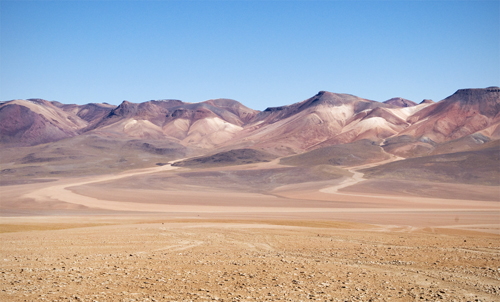
Ania and I arrived eager to get lost in other-worldly destinations like the massive salt flats of the Salar de Uyuni and jagged canyons that make up the Valle de la Luna. As we learned in the Amazon, Bolivia is a nation of extremes and the most isolated places are only accessible through tours, which is lame, but what else can a cash-strapped traveler do?
We hired a driver for a three-day desert tour to the Chilean border and when we crossed over, Ania and I took exploration into our own hands by renting mountain bikes. Both experiences had their pros and cons, but in the end, the heavy Atacama sun pounded our shoulders, the dry desert air made our skin rough like sand paper, and it was all worth it when we saw the barren desertscape turn into a kaleidoscope of purple every sunset and sunrise.
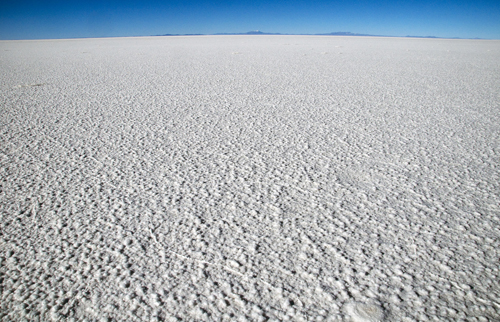
The Salar de Uyuni
Ania and I watched countless herds of llamas pass the bus window and ate even more quinoa-potato soups before we would reach the town of Uyuni and receive one crucial piece of advice: “Try to hire a tour guide that won’t drink and drive.”
As we soon found out, Salar de Uyuni tour agencies vary greatly in quality and the amount you pay is not always an indicator of the experience you’ll get. Breakdowns, flat tires, bad food, alcohol-induced accidents: a lot can go wrong on a multi-day off-road tour through the open desert.
For better or worse, we chose the Estrella del Sur agency to take us on a three-day tour through the Salar de Uyuni and Eduardo Avaroa Andean Fauna National Reserve before dropping us off at the Chilean border. Total price: $700 Bolivianos, or about USD$100 with food, accommodation and park fees included.
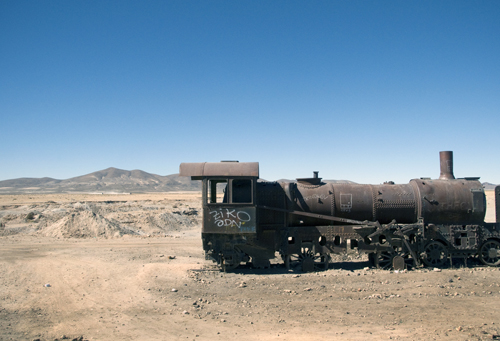
We began early in the frigid morning air. The driver pulled up in a Toyato Landcruiser. His name was Fredo and he looked sober, which was good, so we loaded the car with four Irish medical students that would make up our tour group for the next three days. Our first stop was an enormous abandoned train graveyard outside the town, an orgasm for photographers and rust enthusiasts, but Fredo told us we had 10 minutes to explore the site so we could rush to the second stop, a gift shop that sold little llamas made from salt, where we would spend half an hour.
With souvenirs tightly secured in the back, we entered the Salar de Uyuni, the largest salt flat in the world. A place is so large and so flat that Earth observation satellites use its surface to calibrate their altitude meters and global positioning systems.
According to fossil records, the Salar was part of prehistoric Lake Minchin more than 30,000 years ago. Standing at 11,995 feet above sea level, Lake Minchin would’ve competed with Lake Titicaca for highest lake in the world, but it dried up thousands of years ago, leaving behind the flat concentration of salt we see today.
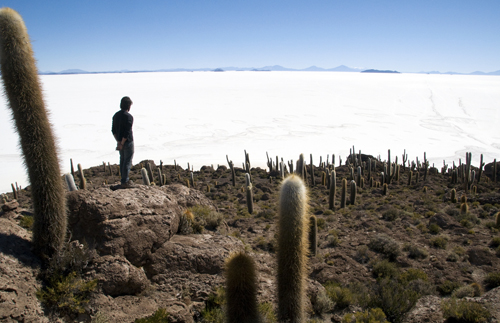
As we drove through the blinding white leftovers of history, Fredo explained the volcanoes around us used to be islands when the lake was still around. We took a chance to stop at Isla Incahuasi, one of the small “islands” in the middle of the Salar, and got out for a short hike on the rocky outcrop. Here visitors can walk over old corrals that once housed prehistoric lake creatures and stand among giant cacti that grow one meter per century. Not bad.
When we returned to the car, Fredo cooked up a few Alpaca steaks and we ate lunch as he boasted about how Alpaca meat was free of cholesterol. Not bad at all. The tour was looking good at that point.
Then the Irish students blasted Lady Gaga music in our car as Fredo rushed us out of the Salar. He said we needed to reach the hostel before sunset, which was confusing since the tour agency told us the highlight of their tour was watching the sunset from within the Salar. Basically, it was main reason to visit the salt flats and we’d be missing it. A tragic realization, but perhaps not as tragic as finding out people over the age of 20 are willfully listening to Lady Gaga.
Without stopping another time on the salt flat, we arrived at the hostel by 4 p.m. and were told dinner would be served in three hours so we could sit and have tea or something. Ania and I took the chance to run away — far, far away — from the tour group and went back into the Salar on foot.
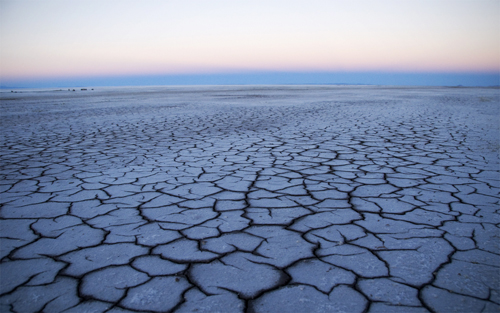
Though we didn’t get far — the place is 4,000 square miles — we did finally get some quality time with the barren land, the silence and the nothingness to contemplate very serious questions. Local legend says mankind was born from Lake Titicaca, but Ania and I figured it was more likely that our ancestors crawled out of Lake Minchin after the water dried up.
It all made perfect sense as the sun set and our shadows grew long while the sky turned into bands of orange, purple and yellow, each color reflecting off the white surface of the Salar.
“I wouldn’t mind dying here,” I thought to myself. And then it got cold and we went back to the hotel for dinner.
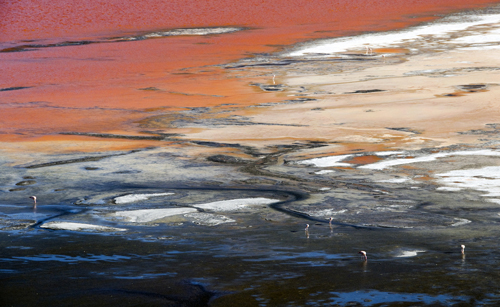
The Eduardo Abaroa Andean Fauna National Reserve
Early the next morning, Ania and I made another short trip into the Salar to watch the sun rise and have one more holy experience before breakfast. We came back frozen stiff, ate and then waited for Fredo, who showed up 30 minutes late only to take us on a short ride to the nearest store, where he would sit and talk with the owner for another 45 minutes. All the other tour groups were way ahead of us.
When he was ready, we drove quickly through a region of multi-colored lagoons with Andean flamingos wading through volcanic hot tubs and stopped briefly to take in the surreal imagery as Fredo repeated, “Come on, don’t go far from the car, we don’t have time.” I wanted to punch him in the face.
The rest of the tour pretty much went on like this. Inside the Eduardo Abaroa Andean Fauna National Reserve, we drove through some of the most beautiful scenery in the world to the soundtrack of Lady Gaga and never seemed to have enough time. Volcanos, geysers, boiling mud pits, petrified lava fields, peculiar rock formations, splashes of paint on martian landscapes — the sights were truly amazing, but less enjoyable when broken down into standardized drills: Drive, step out, take a picture, drive.
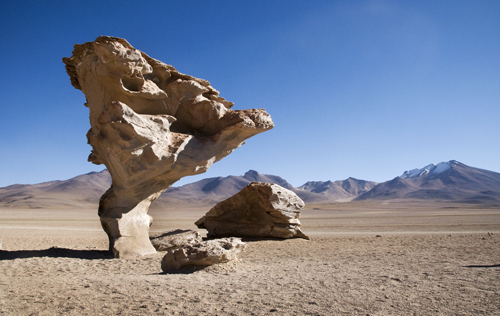
Maybe this is what the tour is supposed to be, but the other tour groups didn’t seem so rushed. Not to mention our Irish car mates’ non-stop celebrity gossiping. Oof. Maybe it was just bad luck.
The last day of the tour, I met a Chilean photographer who shared my grievances and he gave me some good advice: Take the Salar tour with a Chilean company.
This was his third time through the region (fist time with a Bolivian company) and he said Chilean agencies cost a little more, but they provide a much better tour than Uyuni-based companies. It’s the same three-day trip, only backwards so you finish at the Salar de Uyuni.
“Basically,” he said. “Chilean agencies are more likely to deliver the experience they advertise.”
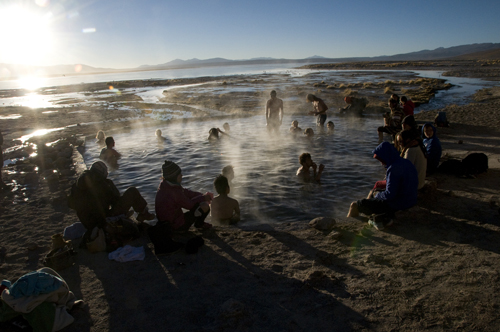
Still, the photographer was explaining all this as we sat in a natural hot spring, watching the sun rise through the steam of a distant volcano. The small inconveniences of the trip were worth the the scenery. It could’ve been much worse. We simply had high expectations for the Salar tour.
That said, Ania and I got dropped off at a lonely bus stop they called the Chilean border, and vowed never to take a tour again.
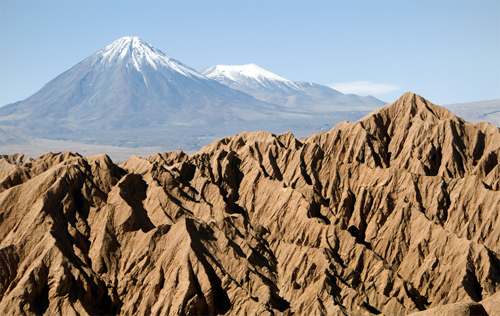
Into the Atacama Desert
An hour after descending 2,000 meters (about 1.25 miles) from the Altiplano, Ania and I reached the Chilean customs office in San Pedro de Atacama where security guards took our apples, calling them a threat to national security even though they were labeled with “Grown in Chile” stickers.
Rules, regulations, working toilets and organic flax seed granola bars — we crossed an imaginary line in the desert and everything changed. After four months in the Andes, Ania and I came down from the indigenous Altiplano and fell back into what most people would would call “Modern Western Society.”
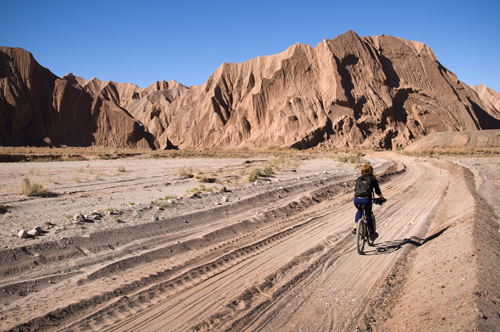
Without hesitation, we took this opportunity to rent mountain bikes. It was recommended by every traveler we crossed and costed about USD$10 for a day, so what the hell? With a map in hand, we set out for the Atacama desert on our own.
We rode through shallow rivers to a red quartz canyon they call the “Throat of the Devil.” We circled spiraling rock towers. We climbed whatever peak looked interesting and rested in whichever shade seemed inviting. It was a much easier to enjoy the landscape without a guide telling us what to do.
The main drawback to this approach is that we got lost out there. Far away objects can appear closer than they really are in wide open spaces. While trying to find the famed Valle de la Luna, we pedaled about two hours in the wrong direction. Still, in the confusion, we found a few cliffs with unforgettable views over the hypnotizing valley and enjoyed its lunar surface from above.
Sure, we never made it inside Valle de la Luna, but it didn’t matter. We were more than satisfied. This was adventure. This was the reason we had come to the Atacama, a place where the sun burns, the shade freezes and the dry air makes alligator scales out of your skin. Mars climate. Peace at last.
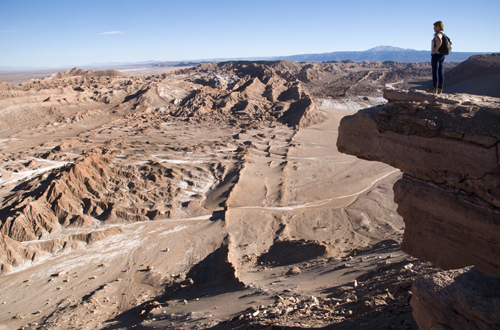
Hitchhiking South and Beyond
There’s a lot more to do in San Pedro de Atacama, but we couldn’t afford it. More salt flats, more hot springs and more geysers. It’s worth a longer visit. Instead, Ania had a plane to catch. After 10 months, our trip together was coming to an end.
With too many stories to tell, we hitchhiked to the paradise port city of Valparaiso, then Santiago, and then all the way over to Buenos Aires where we would slam on the brakes and fly through the windshield. Ania landed in plane seat back to Montreal, which was sad, and I landed in an office chair where I would work for the next five months, which was only slightly less sad.
Without a doubt, we would be reunited again, but not before I finished this long journey and reached the end of the road in Tierra del Fuego.
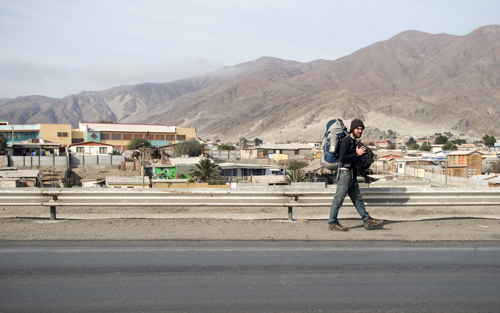
By Diego Cupolo
Coming up next, the final installment of Pan-American Transmissions: La Carretera Austral: On a Gravel Road to the End of the World.
Read all of the other Pan-American Transmissions entries here.

About the Author
 Diego Cupolo is a freelance photojournalist currently on the road to Tierra del Fuego. Most recently he served as Associate Editor for BushwickBK.com, an online newspaper in Brooklyn, and his work has appeared in The New Yorker, The Atlantic, The Star-Ledger, The Australian Times, Discover Magazine and many other publications. View more of his work at DiegoCupolo.com.
Diego Cupolo is a freelance photojournalist currently on the road to Tierra del Fuego. Most recently he served as Associate Editor for BushwickBK.com, an online newspaper in Brooklyn, and his work has appeared in The New Yorker, The Atlantic, The Star-Ledger, The Australian Times, Discover Magazine and many other publications. View more of his work at DiegoCupolo.com.
The post The Driest Place on Earth: From Bolivia’s Salt Flats To Chile’s Atacama Desert appeared first on The Expeditioner Travel Site.
]]>The post Top 5 Countries For Teaching English Abroad (That Aren’t in Asia) appeared first on The Expeditioner Travel Site.
]]>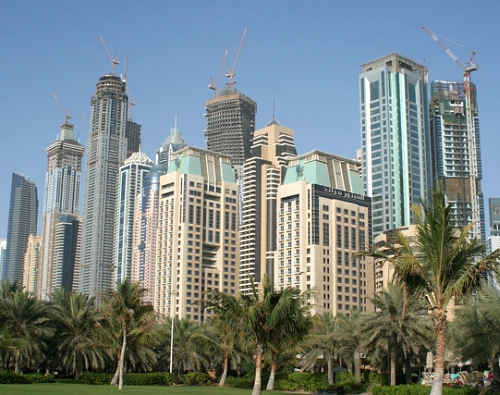
When it comes to jobs teaching English abroad, South Korea and Taiwan are the headliners. Teaching English jobs are easy to find, and high salaries and free housing are some great incentives to head east, but it’s not enough to lure everyone. There are a lot of motives behind your move: curiosity about a certain culture, the chance to learn a new language and the opportunity to experience the local community as an insider.
Asia won’t cut it for everyone. Whether you have your heart set on living in a Spanish-speaking town, or want to immerse in an Arabic community, here are five popular countries for teaching English abroad.
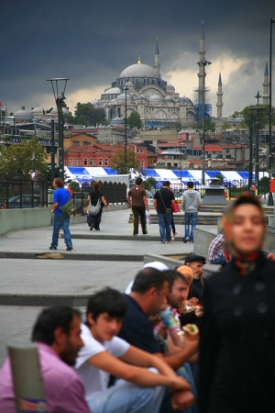 1) Turkey
1) Turkey
This Muslim nation is literally the meeting of two worlds. Stand on the west side of Istanbul’s Bosphorus bridge and you’re in the “old city” of Middle East streets and squares. Cross the river and you’re on the European continent. Istanbul, which is Turkey’s largest city but not its capital, is a sprawling collage of street markets, mosques and modern boulevards.
While the country is still developing, especially in its rural areas, Istanbul is as metropolitan as Brussels or Rome. Ankara, the country’s capital and second-largest city, has many English language academies and big chain schools, such as Wall Street Institute, which are also found in Istanbul. Other cities like Adana and Izmir and are other popular places to finding teaching jobs. The bottom line is to make sure to have a TEFL/CELTA certificate, as most teaching jobs in Turkey require one along with bachelor’s degree. (For more information check out teaching jobs in Turkey via GoOverseas.com)
2) Russia
There are a lot of opportunities to teach in Russia, and the opportunity to learn the language can be one of the most rewarding experiences. Russian can be challenging, but it’s one of world’s most influential languages, from classic literature to current world politics.
Due to Russia’s strong role on the world stage, there is a strong desire to learn English here. Adults and children (for the most part) take extra efforts to learn the language, and there are a lot of private language schools offering classes as a supplement to their education. If you’re new to Russia or teaching abroad, it might be a good idea to work with one of the big chain schools, which sometimes offer housing assistance or teacher training.
Venture outside the large cities of Moscow and St. Petersburg, and you’ll still find teaching opportunities throughout Siberia and along the borders of Central Asia. Check out towns like Vladivostok, Krasnodar and Novosibirsk to find local language schools. If you have a TEFL/CELTA certificate, a college degree and a bit of teaching experience, you should be able to find jobs easily. (For more information check out teaching jobs in Russia via GoOverseas.com)
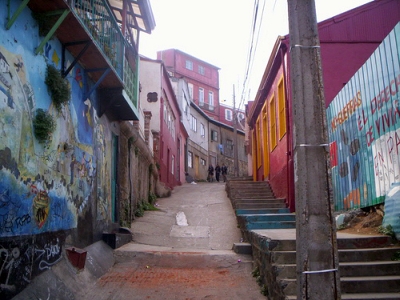 3) Chile
3) Chile
Known for its excellent wine, epic coastline and some of the most untouched wildlife on Earth, this country draws nature lovers from all over. Like most of South America, it’s difficult to arrange a job before arriving. The schools want to meet you face-to-face before hiring, so plan on going door-to-door, handing out resumes and networking once you’re on the ground.
This might sound daunting, but most people are able to find a job within several weeks. Since over 2/3 of Chileans live in urban areas, the capital, Santiago, might be your best bet for getting started, because of the high concentration of English language schools in this area.
The best jobs require TEFL/CELTA certificate and a college degree. If you prefer to go through a program, check out the English Open Doors, a joint initiative between the Chilean Ministry of Education and the United Nations Development Organization. As a volunteer, you can be placed anywhere in the country, from the mountainous Patagonia to the seaside suburbs of Valparaiso. You don’t need a TEFL certificate, and housing is provided with a host family. Don’t expect to build your savings in Chile, but it’s definitely possible to live comfortably with most teaching jobs.
4) Spain
Thoughts of sangria, siesta and sun make Spain a highly desired landing spot for foreign teachers. However, if you’re not from the EU, there’s one hurdle you’re going to have to clear before it all begins: the work visa. In order to legally work in one of the European Union’s 27 countries, you need this important piece of paper. But in order to get one, you need a formal job offer. And now the Catch-22: In order to get a job offer, the employer needs to prove that there isn’t an EU citizen that can do the job better than you. But there’s a loophole. For a monthly stipend, you can teach English through the Spanish government’s North American Language and Culture program, which automatically sponsors the visa for you.
If you want to be adventurous and just show up in Spain without a program, try looking for jobs in Madrid, Barcelona, Bilbao or Seville, which have a lot of language schools and academies. Nowadays, jobs are a bit tougher to find in Spain than they were before the financial crisis, but it’s still possible. You won’t walk away with much savings, but the memories from living the Spanish lifestyle are forever.
5) United Arab Emirates (UAE)
Want a tax-free salary? Get a job in Dubai. This city is a rapidly growing international business and tourism hub, and the demand to learn English is extremely high. Since most of the country’s wealth comes from its booming oil industry, most teaching jobs are at international corporations or universities. The vast majority of jobs require master’s degree, and usually several years of teaching experience. Compared to neighboring Saudi Arabia, women are gaining more equality and opportunities in the UAE, but the different cultural and social attitudes towards them is something that foreign women should be aware of if they are considering teaching here.
[Dubai Skyline by Ross Hawkes/Flickr; Süleymaniye Mosque by laszlo-photo/Flickr; Valparaiso by Dave_B/Flickr]

About the Author

Andrea Moran is the Director for Teach Abroad at GoOverseas.com, a community-driven website of like-minded people who are all passionate about teaching, studying and volunteering abroad. She can be followed on Twitter @Go_TeachAbroad.
The post Top 5 Countries For Teaching English Abroad (That Aren’t in Asia) appeared first on The Expeditioner Travel Site.
]]>The post Will Patagonia Become A Vast Factory For Electricity? appeared first on The Expeditioner Travel Site.
]]>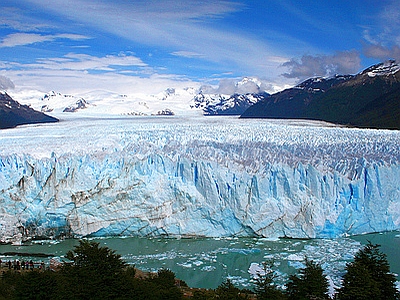
Well folks, it’s really happening. Our exploding human population has forced the search for new energy resources all the way to the end of the Earth. Yep, that’s right, the energy apocalypse is finally upon us, and I never even bothered to invest in that solar-powered book light I had been saving up for.
Okay, so maybe I’m exaggerating a bit, but the repercussions of what may happen to one of the world’s last remaining raw wildernesses just may be grounds for a little embellishment.
The Financial Times recently reported that an expansive area of Patagonian wilderness encompassing the mighty Pascua river, temperate Valdivian rainforests, two continental ice sheets and the largest span of permanent ice outside Antarctica and Greenland, has been sitting under the ticking time bomb of a potentially destructive hydroelectric project.
Proposed by Endesa Chile, a former state-owned power company now owned by Italian and Spanish energy firms, the $7bn HidroAysén scheme is centred around the construction of five large dams on the Pascua and the nearby Río Baker, which will flood some 23 sq miles of forest.
Together with local partners, Endesa plans to build a 1,180 mile transmission line, much of it through temperate forests of a type found nowhere outside Patagonia. Protected by a logged corridor more than 300ft wide, the power line would become one of the world’s longest clear-cuts.
This pristine stretch of natural landscapes, officially dubbed the Región XI, Aysén, has been a popular destination for hikers, climbers, nature lovers and those looking for some sweet adventure while kayaking, fishing and biking in a truly undisturbed environment.
In the past, Chile has relied on Argentina for energy by importing natural gas, but since 2004, the demand for energy has increased so much that Argentina can barely supply its own market, leaving Chile’s growing demand (6 percent annually) unquenched.
The Endesa project is extremely controversial to say the least, and the stakes are high for both nature and man. It is believed that 14 national parks will be affected, and the habitat of thousands of endemic species put at risk. Another large concern is that if the project is approved, it will open the door to a slew of other power projects that could ultimately decimate the region.
It seems as though the Endesa project is a stark reflection of the growing resource shortages worldwide. It’s that grossly familiar battle between the preservation of nature and the struggle to support the growing wants of mankind. The most frightening aspect of it all is that in this fight, the winner may take all.
[Perito Moreno glacier by pclw/Flickr]
By Maria Russo

About the Author
 Maria Russo is a freelance writer who loves natural wonders, good eats, ethical travel, and boutique hotels. Her work has appeared on the Huffington Post, USA Today.com, People.com and A Luxury Travel Blog, among others.
Maria Russo is a freelance writer who loves natural wonders, good eats, ethical travel, and boutique hotels. Her work has appeared on the Huffington Post, USA Today.com, People.com and A Luxury Travel Blog, among others.
When Maria is not writing for her all-time favorite site (that would be The Expeditioner), she spends her time blogging about foreign jaunts and delectable food experiences for her site: Memoirs of a Travel & Food Addict. She is also up to no good on Twitter (@traveladdictgrl, @expedmaria).
The post Will Patagonia Become A Vast Factory For Electricity? appeared first on The Expeditioner Travel Site.
]]>The post What Does The U.S. Have Against Brazilian Tourists? appeared first on The Expeditioner Travel Site.
]]>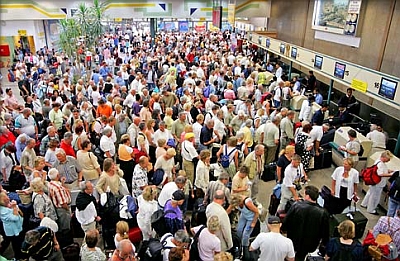
Let’s face it, the U.S. economy is limping along at best, and the last thing it should be doing is making it difficult for people outside of the country to come and spend money here. Take Brazil for example, a nation which spent a whopping $5.9 billion in the U.S. last year. Not that the U.S. made it easy to do so, as Time pointed out in a recent exposé that detailed the difficult process Brazilians, and Latin Americans in general, have in making their way to America.
Instead of rolling out the red carpet for the travelers from the increasingly wealthy South American nations, the U.S. makes Brazilians — and every other Latin American nationality — undergo a lengthy and expensive visa-application process that takes months of planning and can cost thousands of dollars in travel, lodging, food and other expenses — all before leaving the country.
The article notes how there are only four consular offices there — one in Brasilia, Recife, Rio de Janeiro and São Paulo — this, a country of 190 million people and basically the size of the U.S. Wait times for visa interviews, which is about 30 days around the world, can take up to 141 days, and São Paulo alone processes 2,300 visas a day, making it the busiest consulate office in the world.
Perhaps the solution is to allow Brazil into the U.S. visa waiver list, something it allows for numerous other countries. But it turns out Brazil is not on that list, in fact, no Latin American country is.
There are currently 36 countries on Washington’s visa waiver list, but none of them are in Latin America. Some argue it’s hampering the U.S.’ economic growth and global competitiveness. For example, Chilean tourism to the United States is down more than 30% from 10 years ago, while globally the number of Chileans traveling overseas to other countries is up 50%.
And if you think this issue doesn’t affect you, you’re wrong. Chances are you or someone you know is looking for a job, and the article notes how allowing Brazil and Chile alone into the waiver list would, by some estimates, create 1.3 million new jobs and bring in $858 billion into the U.S. economy by 2020. I think the time’s ripe for a consulate construction boom.
The post What Does The U.S. Have Against Brazilian Tourists? appeared first on The Expeditioner Travel Site.
]]>The post What It’s Like Visiting Neruda’s 3 Houses In Chile appeared first on The Expeditioner Travel Site.
]]>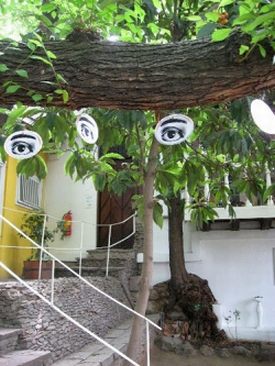
You can count on seeing an oversized men’s shoe, a life-sized photo of Walt Whitman, and windows shaped like those on a boat when you visit famed poet Pablo Neruda’s three houses, all within the Chilean capital of Santiago or a short trip from there, as detailed recently by the LA Times. Having known little about the man (embarrassingly enough), I was quickly turned into a Neruda convert myself shortly after visiting his house in Santiago, La Chascona.
There’s something addicting about his work that has made fans of millions around the world, and even inspired one of the best Italian films of the last half-century, Il Postino. And just like how certain pets look like their owners, the same can be said about Neruda and his famed houses (the other two are called La Sebastiana and Isla Negra). The houses are a must-see when in Chile. However, beware, you may never look at the world the same way again.
The post What It’s Like Visiting Neruda’s 3 Houses In Chile appeared first on The Expeditioner Travel Site.
]]>The post Perilous Patagonia In Peril appeared first on The Expeditioner Travel Site.
]]>
It has been some weeks since returning from the Argentine-side of the Patagonian region. I was affected by its immensity and beauty. To be quite honest, I find the experience hard to put into words — which is the reason I have not written extensively on it.
From Bruce Chatwin to a little Canadian lady, most people that venture into Patagonia end up falling in love with the place. Perhaps it´s the people, the clean air, or the sense that you have seen the closest thing to the end of the world. No matter what happens, people are moved.
I heard from someone — quite possibly a Chilean — that the Chilean Patagonia is much more beautiful because of its impressive terrain. After reading an article in the Montreal Gazette, I get the sense that this is true.
In his article, Mark Angelo describes the condors floating on thermal currents, the glistening pampas and precipitous peaks of the Andes. As he states, ¨[t]he beauty of Patagonia can be captivating, and it’s a place where nature shows a flair for the grandiose.¨ I couldn´t agree more — and neither can a lot of tourists.
Since the eco-tourism boom, Patagonia has become, as Angelo defines, the tourist´s next ¨edge destination,¨ all due to its immensity and remoteness. However, the scenery is not the only thing attracting international attention.
Along with its natural flair to impress comes the exploitation of ¨renewable resources.¨ Heartbreakingly, the Patagonian region has become the target for hydroelectric dams, a subject explored by an article in National Geographic.
The major concern for environmentalists worldwide is the lack of protection for the Patagonian waters that are privately owned since the Pinochet regime. As a result, the landsacape is rapidly changing mostly from the alterations of water sources for dam projects and the waste produced by salmon farms.
Nevertheless, both articles hope for a change as a result of increasing international interest in protecting Patagonia. Hopefully, by the time this protection is in place, it won´t be too late.
By Brit Weaver

About the Author

Toronto born and based, Brit is an avid leisure cyclist, coffee drinker and under-a-tree park-ist. She often finds herself meandering foreign cities looking for street eats to nibble, trees to climb, a patch of grass to sit on, or a small bookstore to sift through. You can find her musing life on her personal blog, TheBubblesAreDead.wordpress.com.
The post Perilous Patagonia In Peril appeared first on The Expeditioner Travel Site.
]]>The post Now You Tell Me What Not To Do In Chile appeared first on The Expeditioner Travel Site.
]]>Great, now I find out I wasn’t supposed to go to the Concha y Toro winery — just outside of Santiago, Chile — because it’s considered “wine for dummies” (I don’t know, I thought the wine was quite good myself), and, instead, I should have trekked to the Casablanca or Colchagua valleys to sample the country’s best wines.
For a few more tips, this week Matador’s continuing their “What NOT to Do in . . .” with Chile, a country where, according to #9, you’re not supposed to try to speak the language (well, you can try, you’re just probably going to be unsuccessful), or eat the salmon (#8 — it contains antibiotics and dyes banned in many other countries).
My own “Don’t Do,” you ask? Don’t schedule your visit there on the tail end of another trip (ahem). With over 2,600 miles from one end to the other, ranging from temperate, desert-like conditions in the North; the Mediterranean vibe in the central region; to the cool, Patagonian region in the South, the country’s way to diverse to pack in during a few days. (Why didn’t I take this advice? Oh yeah, ran out of vacation days.)
The post Now You Tell Me What Not To Do In Chile appeared first on The Expeditioner Travel Site.
]]>The post Valparaíso: South American Dining Mecca appeared first on The Expeditioner Travel Site.
]]>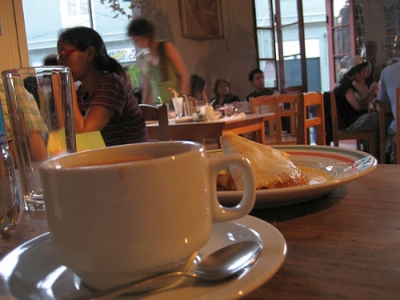
You know there’s something going on in a city’s dining scene when the NYT’s gets wind of it. This week’s travel section highlighted the Chilean port city of Valparaíso where, with over 40 new restaurants in Cerro Concepción and Cerro Alegre alone, the city’s foodie scene is firmly in resurgent mode.
“Unesco made Valparaíso’s historic quarter a World Heritage Site in 2003, and the dining scene has since evolved to match the romantic allure of the city, with its battered cobblestones and crumbling 19th-century mansions.”
To check out some of the best the city has to offer, click through to the article.
The post Valparaíso: South American Dining Mecca appeared first on The Expeditioner Travel Site.
]]>The post Chile’s Atacama Desert Is Out Of This World appeared first on The Expeditioner Travel Site.
]]>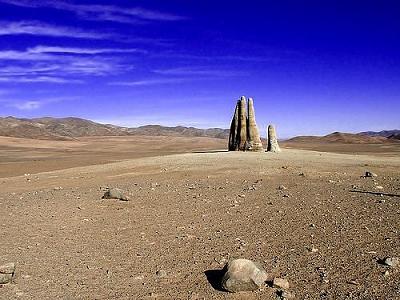
So, I’ve recently figured out a lot about myself. For starters, I’m a sucker for rice terraces, any kind of non-English pop music always sounds better to me for whatever reason, traditional dancing of any kind will mesmerize me, and my newest personal factoid: I dig weird landscapes.
I recently found some amazing pictures of Chile’s Atacama Desert and, literally, an hour passed before I got back to what I originally came to do. First, I was roped in to the area by the Mano de Desierto (Hand of the Desert), reminiscent of our friend and guest contributor, Hal’s recent “Top 10 WTF Statues” post. 75 kilometers from the nearest city, this statue of a hand emerging from the ground looks like a bad result to the Jack and the Beanstalk story.
Then it was pictures of the Valle de la Luna which kept me bouncing around the photo blog. Even the name suggests its other-worldliness, “Valley of the Moon.” I can’t vouch for its moon-like authenticity, but it didn’t look like it belonged anywhere on this planet. I half expected to see creatures from “Where The Wild Things Are” in half the pictures.
Looks like I need to fatten up my travel resume to Chile.
The post Chile’s Atacama Desert Is Out Of This World appeared first on The Expeditioner Travel Site.
]]>The post Don’t Forget Your Floaty Rings: The World’s Largest Pool appeared first on The Expeditioner Travel Site.
]]>
This isn’t your Aunt June’s backyard pool The Guinness record-holding, man-made “lagoon” measures 3,324 feet in length and covers over twenty acres at the San Alfonso del Mar resort in Algarrobo, Chile. Now that’s a pool.
This bad boy comes with nothing but surprises. It’s not chlorine, as I first suspected. It’s actually a patented technology that filters the nearby ocean water so well, that it’s reported you can see up to a a hundred feet down (although, the pool isn’t that deep). How about jumping aboard a sailboat after a stroll along its white sand beaches? If that’s not cool enough, dust off the scuba gear, and practice up before heading into the open water only feet away.
It’s still a pool, remember? A pool so big, it has its own docks (this recent photo spread from the Chicago Tribune proves it). I guess the term “lagoon” is a bit more appropriate then, eh?
The post Don’t Forget Your Floaty Rings: The World’s Largest Pool appeared first on The Expeditioner Travel Site.
]]>The post Top 6 Beach Towns In Chile appeared first on The Expeditioner Travel Site.
]]>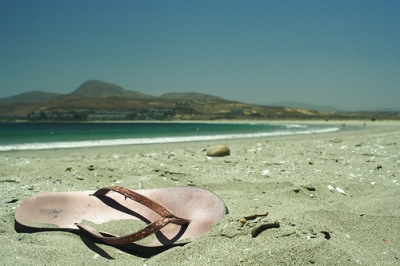
It’s not exactly a secret, but when most people think of Chile, incredible beaches and cool coastal towns do not usually pop into their head (despite the fact that the country has about 4,000 miles of Pacific coastline).
As Cathy explains in this Matador article, these towns have inspired poetry (Neruda – Isla Negra), offered summer getaways for the city folk (Santiago – Viña del Mar), and have arguably been home to some of the country’s best views (La Caleta – Pan de Azucar National Park). Be warned though, these are the type of getaways where caution is thrown to the wind and jobs are left never to be returned to.
By Matt Stabile

ABOUT THE AUTHOR
 Matt Stabile is the Founder and Editor-in-Chief of The Expeditioner. The Expeditioner began in 2008 and is headquartered in New York City. You can read his writings, watch his travel videos or contact him at any time at TheExpeditioner.com. (@TheExpeditioner)
Matt Stabile is the Founder and Editor-in-Chief of The Expeditioner. The Expeditioner began in 2008 and is headquartered in New York City. You can read his writings, watch his travel videos or contact him at any time at TheExpeditioner.com. (@TheExpeditioner)
The post Top 6 Beach Towns In Chile appeared first on The Expeditioner Travel Site.
]]>The post Videos From The South or Videos From Places I’d Rather Be On My Birthday appeared first on The Expeditioner Travel Site.
]]>Okay, cruising through the frozen fjords of Chilean Patagonia may not be a huge departure from the frozen streetscapes of New York, but take a look at some of the views beginning on 2:24 that you’d get if you were there and I guarantee you wouldn’t be thinking twice about the cold. Plus, you’re in Chile. An hour flight and you’re back in warm paradise.
If you have more than a few days to spend in Buenos Aires, why not go ahead and sign up for a few tango lessons? It looks fun, it’s a great way to get a taste of the culture, and why wouldn’t you want to spend most of your waking hours there hand in hand with an instructor like Maria Jose?
The post Videos From The South or Videos From Places I’d Rather Be On My Birthday appeared first on The Expeditioner Travel Site.
]]>The post Zip Line Adventures On The Slopes Of Osorno Volcano appeared first on The Expeditioner Travel Site.
]]>
A Canopy Adventure in Chile
By Valerie Martin
“I don’t want to do it!” Fara hissed. The French tourist’s eyes widened with fear as we stood on a wooden platform, 1000 feet above sea level, on the western slope of the Osorno volcano.
Glacier-capped Osorno is often referred to as the Chilean Mount Fuji. It’s one of the most active volcanoes in the country, with 11 eruptions recorded since the 16th century.
As I peered down the endless steel cable that would send us flying through treetops and over deep canyons, I was suddenly afflicted by some first-timer doubts of my own. What if the pulley breaks? What if I get stuck on the line before reaching the next platform? What if I crash into the tree? What am I doing here?!
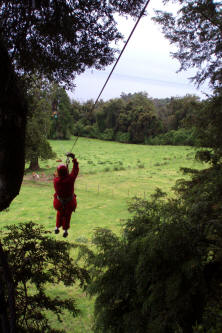 Fara was strapped onto one of the professional guides for an assisted ump into the tree canopy. The rest of the tourists huddled around the massive tree trunk and looked on apprehensively.
Fara was strapped onto one of the professional guides for an assisted ump into the tree canopy. The rest of the tourists huddled around the massive tree trunk and looked on apprehensively.
Barb, an American woman in her mid-sixties and dressed entirely in black leather and matching sunglasses, exclaimed, “If I can bear children than I can do this!” and belted out an appropriately hearty laugh. Barb’s friend Cheri did not look as self-assured.
A long, shrill scream shattered the chilly forest silence as the trembling Fara leaped into the open. As she did this, an inordinately large bumblebee that sounded like a small motorcycle began to accost our little group and destroyed whatever order there was in our disorderly line for the canopy jump.
Next, Cheri tiptoed up to the front as if being led onto the pirate’s plank. “Just scream your fear out! Yell like Tarzan!” I yelled, trying to cheer her on as I battled my own devils.
A moment’s pause and off she went, letting out a resounding holler that began the moment her feet left the platform and did not end until her red-jumpsuit-clad body swung onto the next platform, 100 feet down in the trees.
My turn. I moved to the edge of the platform and the guide hooked the sole ring of my harness to the cable.
“Jump, lift your legs and pull down on the cable if you need to reduce speed,” the guide instructed. An adrenaline-charged zip line adventure was just one lurch away from me.
Osorno stands triumphant over the southeastern rim of Llanquihue Lake, in the mesmerizing Lake District of Chilean Patagonia. At 8,701 feet, the volcano can be seen from the Pacific Ocean, as it was by Charles Darwin in 1835 during the second voyage of the Beagle.
Many European immigrants settled in this area and founded towns that resemble Swiss villages along the rim of the lake. Frutillar, with its German museum and teahouses, and 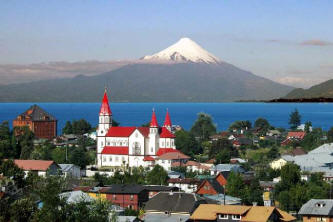 the rose-lined town of Puerto Varas are two of the more popular destinations here.
the rose-lined town of Puerto Varas are two of the more popular destinations here.
With its sapphire lakes, ancient forests, snow-capped peaks, and emerald cascades, this is one of the most visited regions of Chile.
The Lake District is also a haven for eco-tourism and adventure travel. The Vicente Perez Rosales National Park encompasses most of the area. Kayaking, white-water rafting, canoeing, hiking, trekking, horseback riding, fly-fishing; the wide range of outdoor activities offer an up-close view of this natural paradise.
Canopy Lodge Cascadas was the first zip line (or “canopy” as it is called here) in Chile. It was constructed in 2002 by a team of experts who drew on their experience in the rainforest canopy lodges of Costa Rica, where scientific researchers who needed a practical way of getting from one tree to another invented the activity.
More than a mile long, this zip line is the longest in Chile. The entire glide, with steel cables that stretch along 14 platforms, takes about two hours to complete.
Oblivious to these particular facts, I stood on edge of the first platform, took a deep breath and jumped into thin air.
Quickly, my fear melted as I flew between the branches of ancient lenga and coihue trees. I felt sheer pleasure as I listened to the hum of the wind against my ears. The steady zzzzz of my movement along the cable eased me and simultaneously heightened my perception of the profound silence of the forest.
My adrenaline was surging and instead of pulling down on the cable to slow down, all I wanted to do was to go faster.
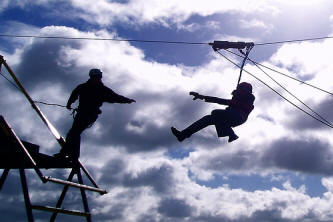 About 30 minutes later, we encountered the diva of this circuit: an 820-foot-long stretch of cable suspended 311 feet over the treetops. Zip liners fly over a wide canyon during a glide that lasts over a minute. It’s enough to paralyze more than one intrepid traveler. Those who manage to turn their heads during the fretful trip can catch a glimpse of a stunning panoramic view of the lake.
About 30 minutes later, we encountered the diva of this circuit: an 820-foot-long stretch of cable suspended 311 feet over the treetops. Zip liners fly over a wide canyon during a glide that lasts over a minute. It’s enough to paralyze more than one intrepid traveler. Those who manage to turn their heads during the fretful trip can catch a glimpse of a stunning panoramic view of the lake.
After the canyon plunge, we breezed through the rest of the circuit, practicing our yells in different registers as we gained in confidence. During another memorable stretch we zipped over a herd of cows that were pasturing on the green foothills of the giant volcano.
Near the end of our two-hour adventure, I bumped into Fara again. Her face was flushed and she was beaming. She had defied her demons and decided to go solo for the last few jumps. Osorno Volcano, for one proud tourist, would be remembered as a journey into fearlessness.

The post Zip Line Adventures On The Slopes Of Osorno Volcano appeared first on The Expeditioner Travel Site.
]]>The post Santiago: The Capital Of Laid-Back Life appeared first on The Expeditioner Travel Site.
]]>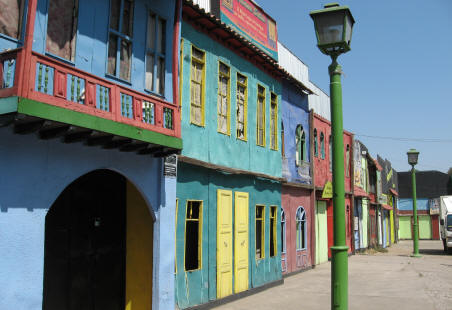
Though Chile is known for its laid-back attitude, it doesn’t take long for one to discover its vibrant culture.
By Matt Stabile
Let’s just say I was already feeling a little light-headed before I found myself thousands of feet in the air, looking out over the Andes Mountains. Buenos Aires is not exactly known as a sleeper-friendly city, and the last five days for me there were no exception. So by the time I got to the Airport for my 5:45 flight to Santiago, Chile — after only heading to bed a few hours before — my head already felt like I had been aloft for several hours.
I was initially going to spend my entire trip in Argentina, but after finding out that my friend’s brother was living and teaching English in Santiago, I decided that I might as well try to see as much as I could in the time I had in South America. There are plenty of daily flights between the two capitals but no discount airlines operating in either of those countries, so I booked a ticket through the large Chilean airliner LAN for US$250.
On a bus ride back from San Antonio de Areco to Buenos Aires I met a trio of girls from Colorado who’d been backpacking around the continent for the last three months. The girl sitting next to me began showing me pictures on her camera and we came across some incredible shots of the Andes from her flight to Argentina. I told her I was flying out the next day and she recommended getting a window seat to get the best view. So the next day on my early-morning flight when the stewardesses disappeared behind the first-class curtain before takeoff, I sneaked into an empty window seat in the bulkhead aisle and promptly leaned my head against the window and shut my eyes, avoiding any impression of impropriety.
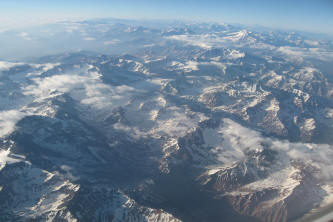
About an hour-and-a-half into the two-hour flight, the pilot announced that we were directly above the town of Mendoza and that we’d soon be flying over the foothills of the Andes. A few minutes later I looked out the window and I could see the gently sloping hillsides suddenly angling upwards, jutting towards the sky and revealing the precipitously angled edges and snow-capped peaks that make up this incredible mountain range; one of the most amazing sights I’d ever seen, and I grew up in Colorado.
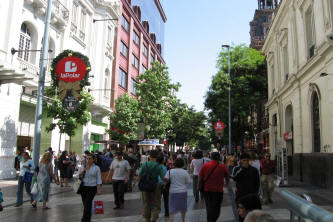
Twenty minutes later we left the Andes behind and descended into the large, arid valley that Santiago calls home. The city itself is located 1,700 feet above sea level, and with five-and-a-half million residents it’s home to more than a third of the country’s population. From what I’d been hearing about the city while I was in Argentina, Santiago’s vibe is noticeably more laid-back than Buenos Aires but there’s still plenty to do if you know where to look.
We landed and I hopped on a bus heading near downtown. I took a seat near the back and I realized that I had no idea where I’d be spending the night.I took out the fold-out map that I’d found inside the airport and saw an ad for the Andes Hostel: a newly built hostel that was located in the center of downtown. After the bus dropped me off I took the subway downtown and walked a few blocks to the hostel. (The exchange was 475 Pesos to the Dollar, and the subway fare is about 420 pesos during non-rush hour times).
The hostel was located in a six-story building, with rooms on the top five floors, a lounge/lobby on the main floor, and a basement kitchen where a complimentary breakfast is served daily. I was given a bed in a room with three bunk beds for $8,000 pesos (or US$15). As the ad said, the hostel and its furnishings were brand new, making it one of the best deals in the city. The one thing they didn’t have was a lending library — only a small stack of books on a coffee table — so to help them out I left a copy of the “Lets Go” that I’d taken from my last hostel.
It was only noon when I got there, so I took a walk to get a feel for the area. I headed ten minutes west on Monjitas into the business section of Santiago where, several years ago, the city redesigned the entire district, eliminating all car traffic and making it the most pedestrian-friendly city-centers in the world.
At the symbolic center of the city is the plaza, Plaza de Armas, where there’s the Catedral Metropolitana de Santiago, the Museo Historico Nacional, as well as hundreds of city dwellers out-and-about, enjoying the weather, having lunch, and listening to one of the many street performers that call the square home. I went into the historic cathedral where the noise and bustle of the city is immediately whisked away and absorbed by the solemnity of the church environment. Dating back to 1748, the cathedral’s ceiling was painted to resemble the frescoes of European cathedrals, and the numerous chapels located within the church are home to an impressive array of artwork ranging from sculptures to full-size portraitures.
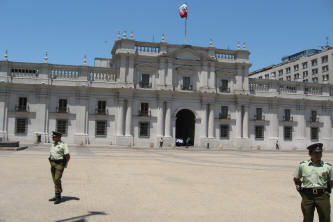
After the cathedral I walked south to a second square, Plaza de la Constitucion, to see the Palacio de La Moneda, or “Mint Palace,” home of the President’s offices and his Cabinet. As I approached the plaza I began to hear a loud roar, and when I got close I saw the source of the noise: today marked the first day of a strike by the state museum workers. In the square there were several thousand protestors chanting and yelling towards the government buildings. Naturally I joined the masses for a bit, but the afternoon heat was getting to me, so I doubled back to the hostel and fell asleep for a few hours while Chile’s fledgling democracy continued on into the day.
That night I met up with my friend’s brother who was with his cousin and girlfriend and we drove to her friend’s house and watched Chile get beaten by Ecuador in football on a T.V. set up in her backyard patio. (Apparently the Chilean football team has been less than spectacular the last few years.)
The next morning I took a short taxi ride into Barrio Bellavista, the eclectic, exuberant neighborhood just north of downtown that’s the center of Santiago’s nightlife. It’s also the home of the city’s historic bohemian culture, and where you’ll find one of the houses of the Chilean icon, Pablo Neruda.
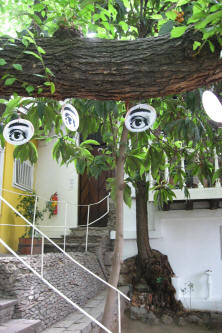 Neruda, the nobel-prize winning poet who, at the height of his fame, was forced to flee Chile due to his leftist political leanings, is revered hroughout the country both for his timeless poetry as well as for his political accomplishments. (He was elected as a Senator in 1945 before being exiled, and in 1970 he was nominated as a candidate for the Presidency which he gave up to support Salvador Allende.) His house in Santiago, La Chascona, is one of three houses he owned, and is actually a complex of small buildings nestled in the hills of Barrio Bellavista. Each building shares a nautical theme, complete with porthole shaped windows and crooked floorboards to simulate a ship’s deck. Neruda was known for his playfulness and this is exemplified in each house by his vast collection of trinkets and eccentric artwork.
Neruda, the nobel-prize winning poet who, at the height of his fame, was forced to flee Chile due to his leftist political leanings, is revered hroughout the country both for his timeless poetry as well as for his political accomplishments. (He was elected as a Senator in 1945 before being exiled, and in 1970 he was nominated as a candidate for the Presidency which he gave up to support Salvador Allende.) His house in Santiago, La Chascona, is one of three houses he owned, and is actually a complex of small buildings nestled in the hills of Barrio Bellavista. Each building shares a nautical theme, complete with porthole shaped windows and crooked floorboards to simulate a ship’s deck. Neruda was known for his playfulness and this is exemplified in each house by his vast collection of trinkets and eccentric artwork.
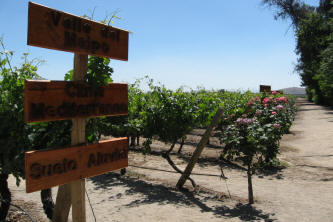
After La Chascona I got on the subway and headed an hour south out of the city and into the Maipo Valley to visit Chile’s most famous and largest wine producer: Concha Y Toro. Far from the bustle of downtown, the Maipo Valley’s land is fertile and the climate is temperate, making it an ideal place to grow high-quality grapes. Concha Y Toro beganas a family affair in the 1800’s, and as the winery grew and made the family rich, they built an amazing mansion overlooking the well-tended grounds, viewable during daily tours. (Reservations are required so call ahead if you want to visit.) For many winery tours, the requisite walk around the grounds is usually a pretext for heading to the bar, but here you’re taken to both the grounds as well as inside and down under the winery into the basement where they store their most famous wine: El Diablo (a name derived from a ghost story concocted to keep the workers from heading into the dark recesses of the building to steal bottles).
My friend and I hung around the bar for an hour or two and sampled a number of their wines, including their Carmanere — a grape once thought to be extinct in Europe, only to be rediscovered flourishing in South America — and their Cabernet Sauvignon, along with a generous fruit and cheese platter. The bar quickly emptied out and we chatted with one of the waitresses who told us how she spent a semester in Wisconsin (she hated the cold) and how much she loved her current job (the waitresses are required to try all the wines in the morning for “quality control”).
Like most places, Thursday night in Santiago is the unofficial beginning of the weekend, and nowhere is this more evident than along the street, Pio Nono, with its outdoor cafes, hopping bars, and various nightclubs. We sat at one of the café tables for a while, taking advantage of their happy-hour and enjoying the warm, night air, and then headed to a couple of clubs where the DJ’s played a rotation of samba and reggaeton with a few 80’s songs mixed in for good measure.
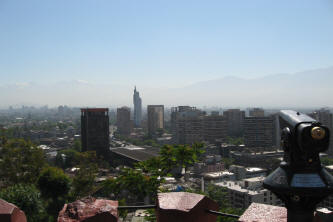
The benefit of flying out Friday night was that I had one more full day to enjoy the city. Friday was a beautifully clear day — perfect for hiking around the downtown park, Cerro Santa Lucia. The park sits on what used to be a large pile of rocks and dirt. The cityhad no idea what to do with the eyesore, so in 1872 they transformed it into a giant park where there’s now a huge variety of floral life, hiking trails and open space for gazing out over the city landscape. I hiked to the center of the park and up a castle-like structure sitting at the top of a bluff where I had an incredible view of the towering downtown skyscrapers and the snow-capped Andes off into the distance, forming a ring around the city.
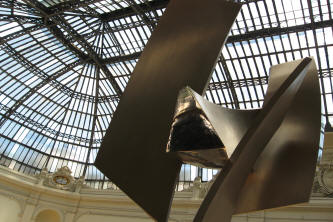
I decided to escape the heat and head indoors to the Museo della Bella Artes for the afternoon to view their large collection of modern art and works by contemporary artists. Thebuilding’s design was based on the Petit Palais in Paris down to the Art Nouveua glass dome adorning the roof of the museum that had to be brought over piecemeal from Belgium in 1907.
After hiking around both the park and the museum I was feeling exhausted, so I wandered across the street to the Parque Forestal. With its massive palm trees providing ample shade and its closely cut grass, the park must be one of the country’s best places for a siesta. I laid down in a quiet section of grass near a couple of dogs that were asleep and I drifted away for an hour, enjoying the last bit of time I had in Chile before I had the chance to return once again.

The post Santiago: The Capital Of Laid-Back Life appeared first on The Expeditioner Travel Site.
]]>